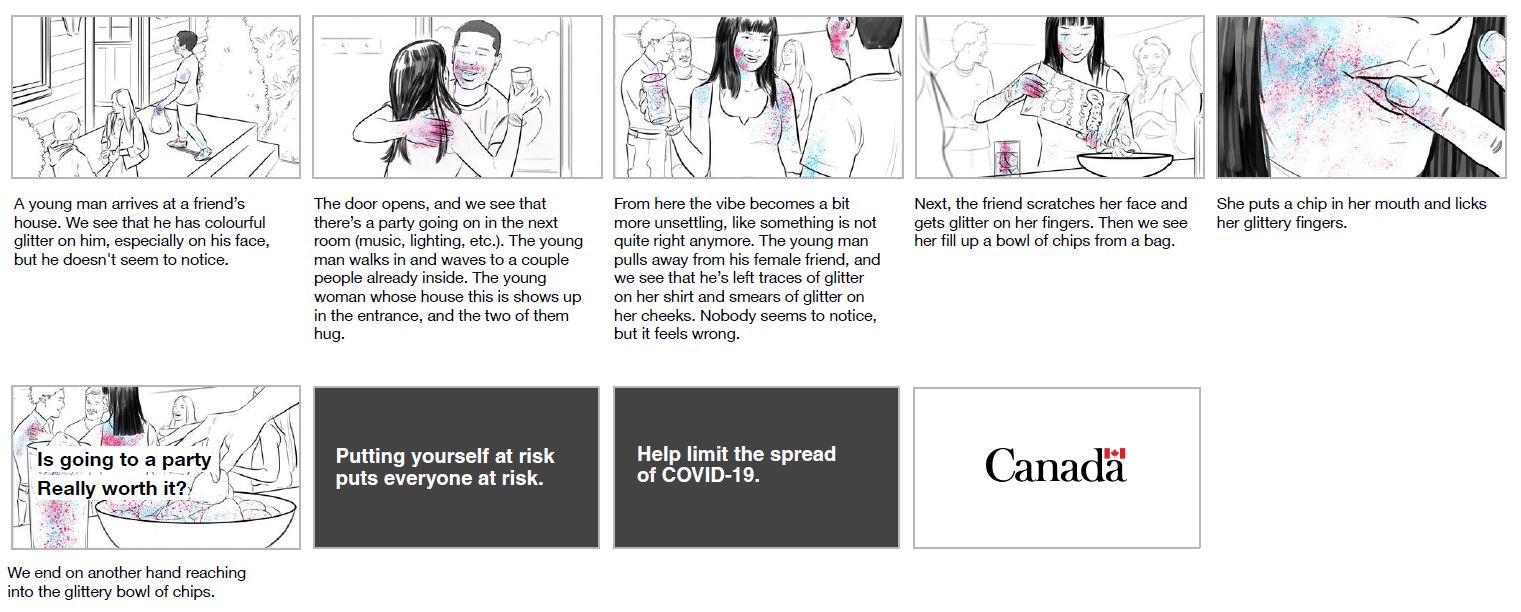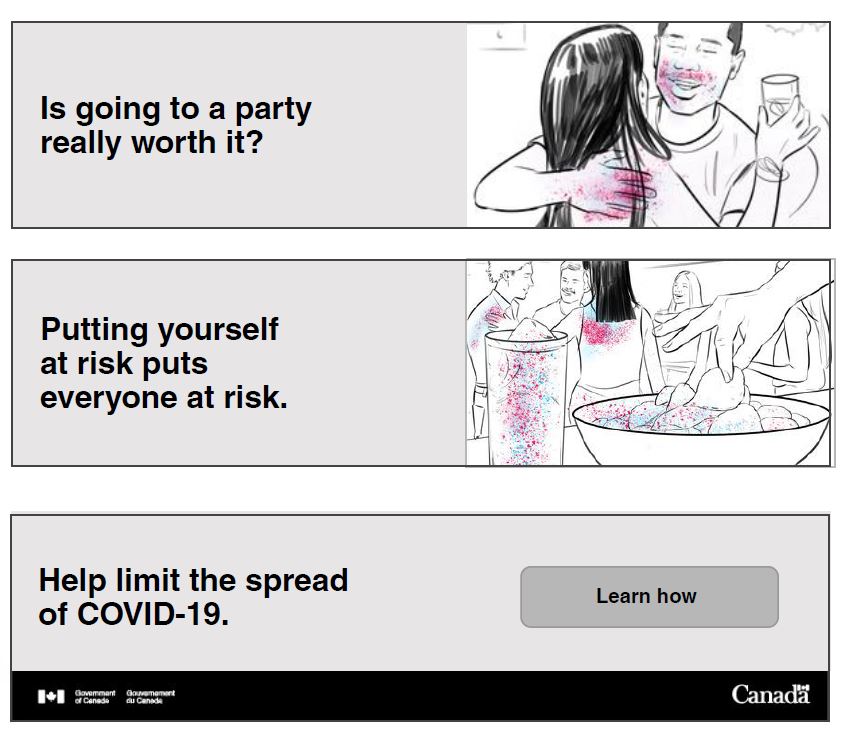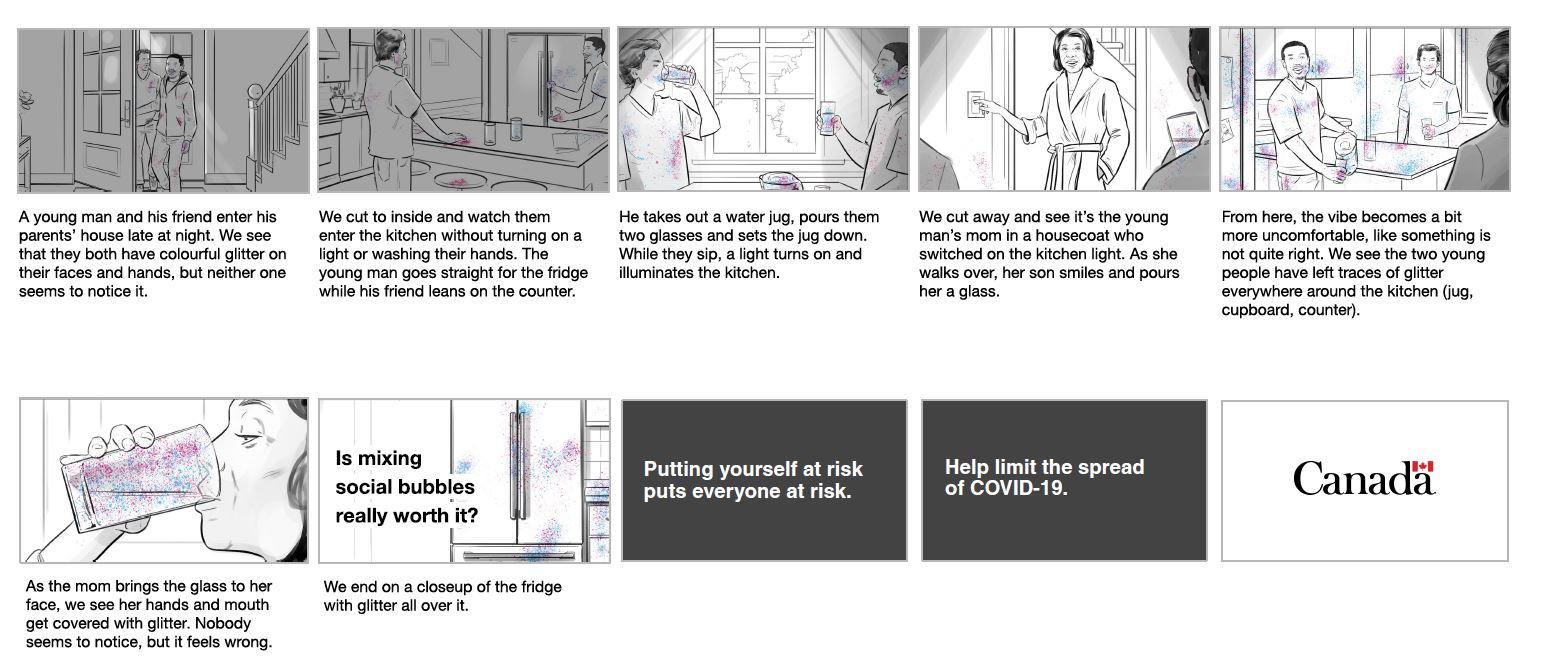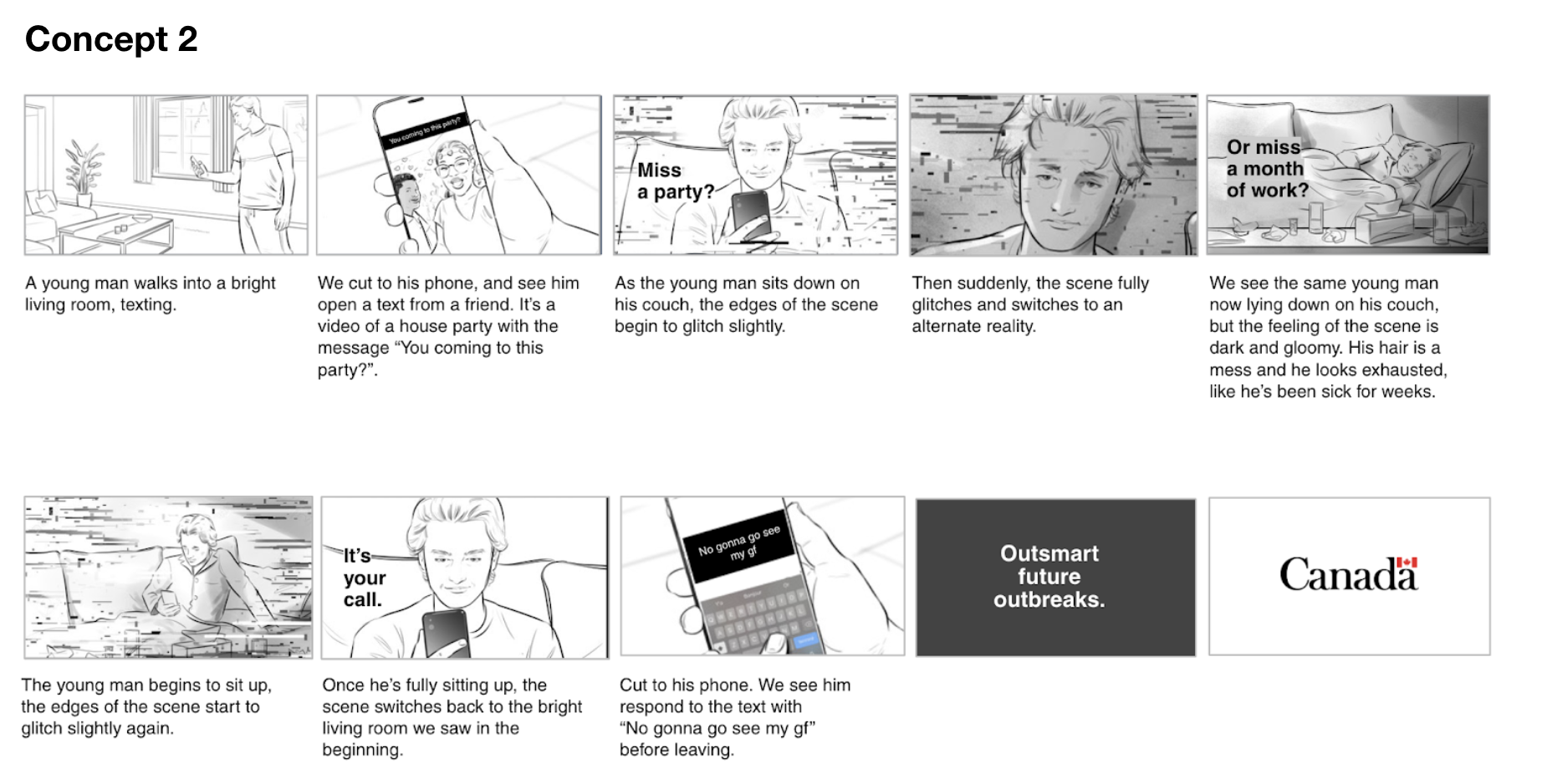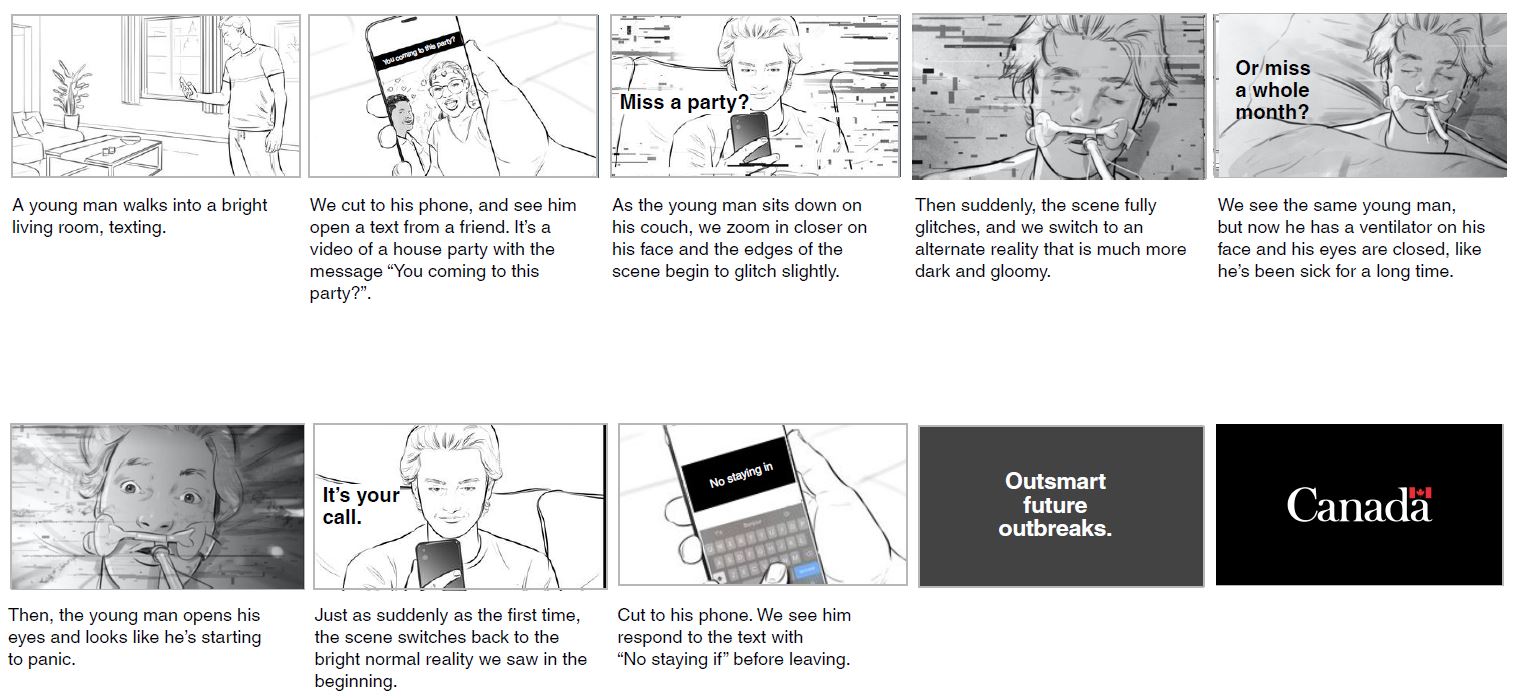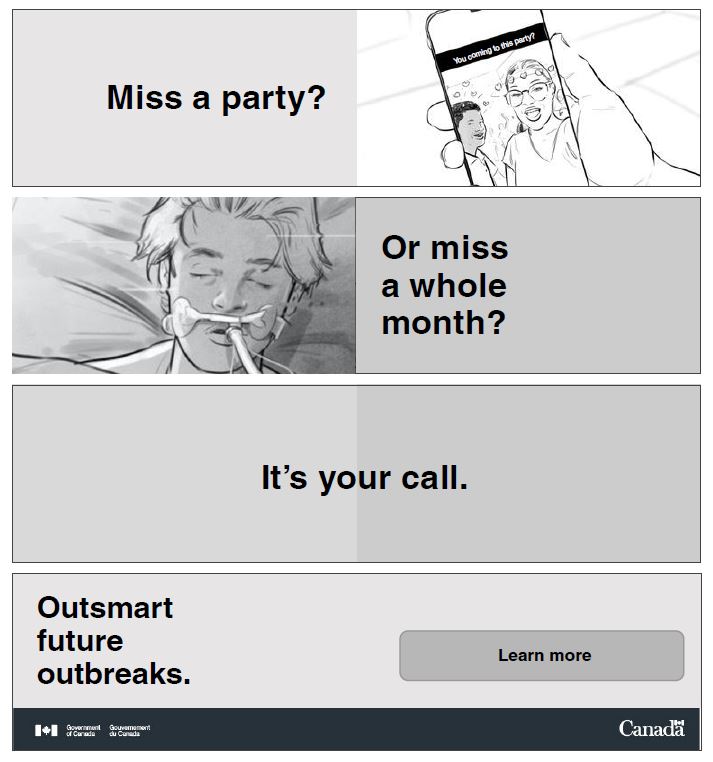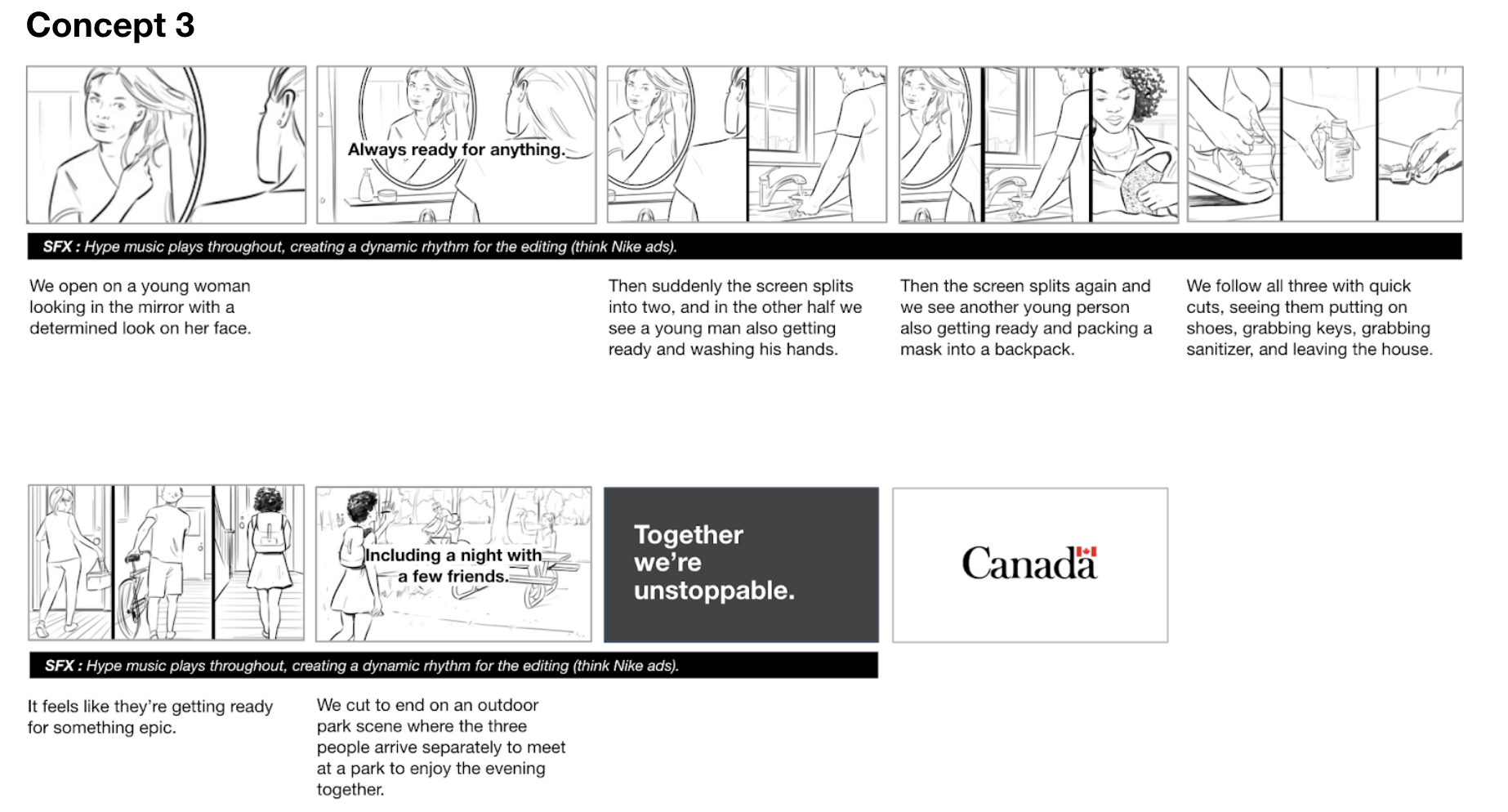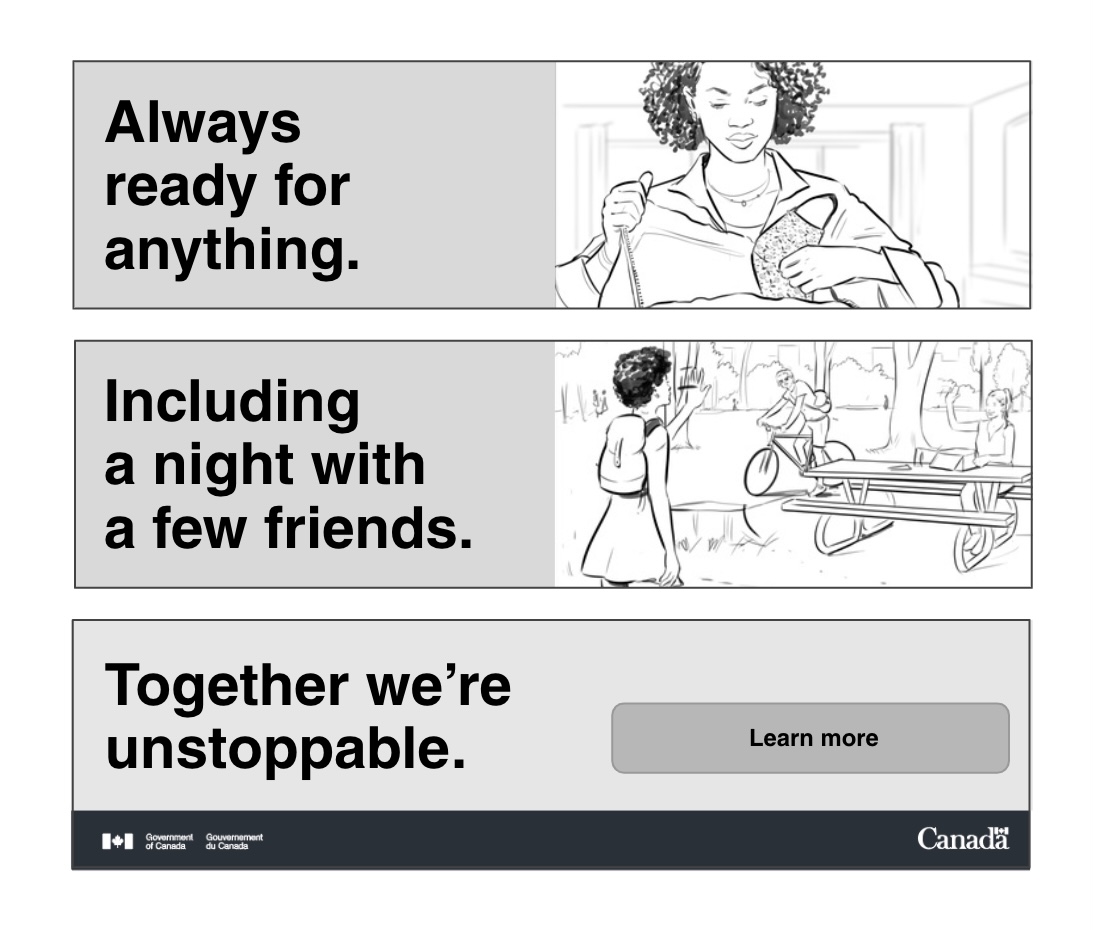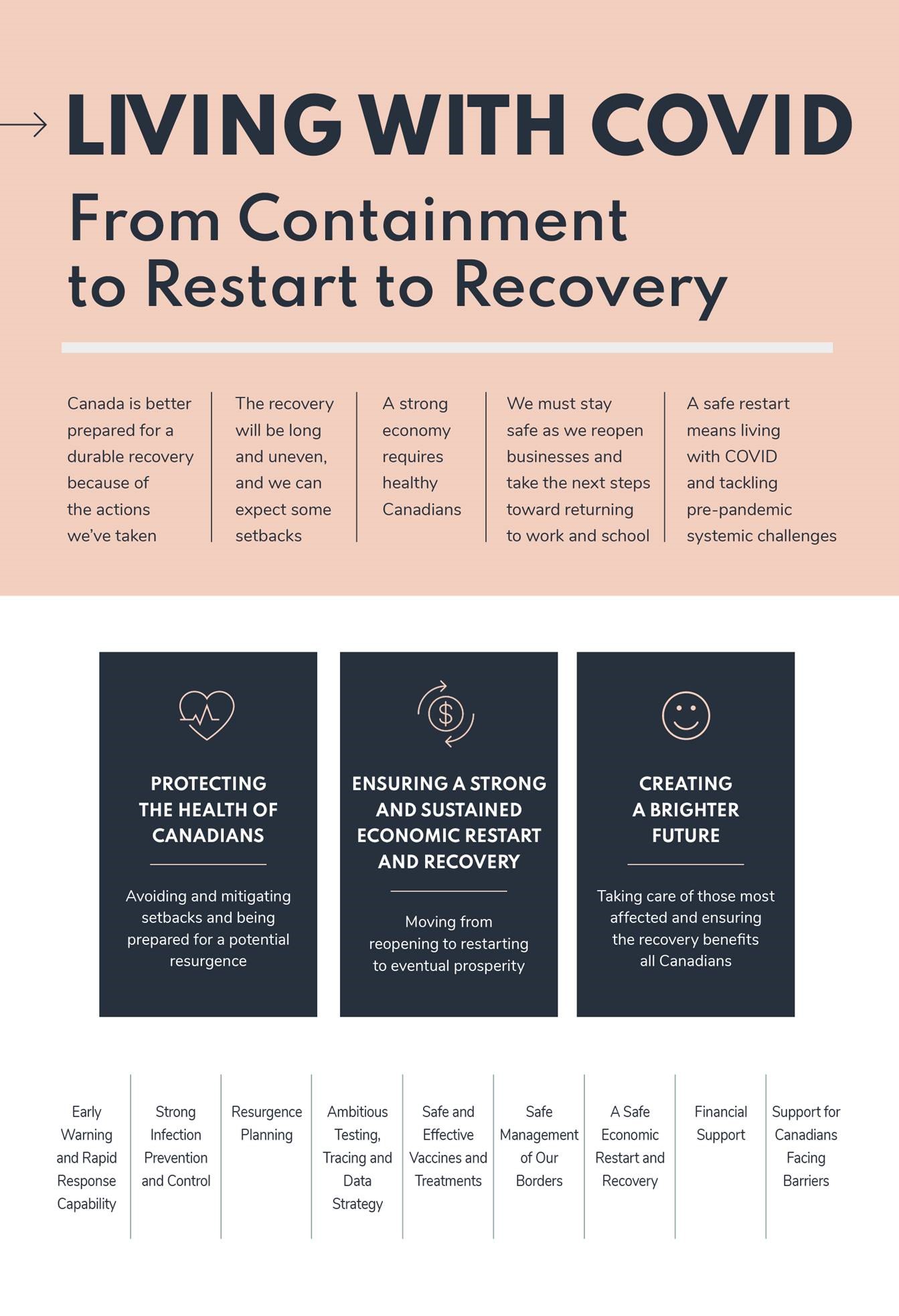MODERATOR’S GUIDE – August 2020
MASTER
INTRODUCTION (10 minutes) All Locations
- Moderator or technician should let participants know that they will need pen and paper in order to take some notes, jot down some thoughts around some material that we will show them later in the discussion.
COVID-19 IN THE NEWS (5-15 minutes) Eastern Ontario Young Adults, Golden Horseshoe Ontario Immigrants, GMA Immigrants, U.S. Border Towns Ontario, Mid-size and Small Town Prairies Seniors, Small, Rural, and Northern Towns Ontario Parents, Eastern Townships Quebec, Vancouver Parents, Interior B.C., Mid-size and Small Town Quebec Parents What
have you heard about the coronavirus or COVID-19 in the last few days?
- Mid-size and Small Town Prairies Seniors, Small, Rural, and Northern Towns Ontario Parents, Vancouver Parents, Interior B.C., Mid-size and Small Town Quebec Parents Have you heard anything about the
Canada Emergency Response Benefit (CERB) recently?
- Mid-size and Small Town Prairies Seniors, Small, Rural, and Northern Towns Ontario Parents, Vancouver Parents, Interior B.C., Mid-size and Small Town Quebec Parents PROMPT AS NECESSARY: Have
you heard anything about transitioning from CERB to the Employment Insurance (EI) system?
- Vancouver Parents, Interior B.C., Mid-size and Small Town Quebec Parents Have you heard anything about eligibility requirements or the minimum amount of money EI recipients will receive
per week, or anything like that? What have you heard?
- Vancouver Parents, Interior B.C., Mid-size and Small Town Quebec Parents Have you heard anything about any new benefits? What have you heard?
Mid-size and Small Town Prairies Seniors, Small, Rural, and Northern Towns Ontario Parents CLARIFY AS NECESSARY –
The last eligibility period for which Canadians can receive CERB ($2,000/month) ends
on Sept. 26. The Government of Canada recently announced that it is preparing to transition as many Canadians as possible back to the EI system at the end of this month.
- Mid-size and Small Town Prairies Seniors, Small, Rural, and Northern Towns Ontario Parents What do you think about transitioning those who will still need income support from CERB to EI? Do you think
this is a good or bad approach? What makes you say that?
- U.S. Border Towns Ontario, Small, Rural, and Northern Towns Ontario Parents Have you heard about the Government of Canada’s new COVID-19 Alert App? Have you downloaded it? Do you plan on doing so? Why?
Why not?
Clarify: The federal government has just released an app that helps break the cycle of infection by letting people know of possible exposures before any symptoms appear. It uses Bluetooth to exchange random codes with nearby phones.
Every day, it checks a list of random codes from people who tell the app they tested positive. If you’ve been near one of those codes in the past 14 days, you’ll get a notification.
- U.S. Border Towns Ontario, Small, Rural, and Northern Towns Ontario Parents Do you think it’s an effective way to stop the spread? For those who are hearing about it for the first time, do you plan
on downloading it?
- Eastern Ontario Young Adults, Golden Horseshoe Ontario Immigrants, GMA Immigrants, Quebec Eastern Townships Have you heard anything else about how the Government of Canada has responded?
- Do you think that, to date, the government has responded appropriately? Why/not? [MODERATOR NOTE: TAKE TIME TO ALLOW RESPONDENTS TO CONSIDER ANSWERS]
- What else, if anything, should they be doing at this time?
- Quebec Eastern Townships How well do you think the Government of Canada is doing when it comes to providing information on how to stay safe? What makes you say that?
CANADA-U.S. BORDER (5-10 minutes) Eastern Ontario Young Adults, Golden Horseshoe Ontario Immigrants, U.S. Border Towns Ontario, GMA Immigrants, Mid-size and Small Town Prairies Seniors, Small, Rural, and Northern Towns Ontario Parents, Quebec Eastern Townships
- Eastern Ontario Young Adults, Golden Horseshoe Ontario Immigrants, U.S. Border Towns Ontario, GMA Immigrants, Small, Rural, and Northern Towns Ontario Parents, Quebec Eastern Townships Have you heard
anything about the Canada-US border recently?
- U.S. Border Towns Ontario, Mid-size and Small Town Prairies Seniors, Small, Rural, and Northern Towns Ontario Parents, Quebec Eastern Townships Have you heard about any other Canada-U.S. issues? PROMPT
AS NECESSARY: Have you heard anything about aluminum tariffs? Mid-size and Small Town Prairies Seniors, Small, Rural, and Northern Towns Ontario Parents, Quebec Eastern Townships What have you heard?
- GMA Immigrants PROMPT AS NECESSARY: Have you heard anything about the trade relations with the U.S., namely regarding aluminum recently?
Quebec Eastern Townships CLARIFY AS NECESSARY
Earlier this month, the United States announced the imposition of tariffs of 10% on imports of certain aluminum products from Canada.
- Quebec Eastern Townships Have you heard how the Government of Canada has responded? What have you heard?
Quebec Eastern Townships CLARIFY AS NECESSARY
In response, the Government of Canada has said it will impose surtaxes against imports of aluminum and products that contain aluminum from the U.S.
- Quebec Eastern Townships What do you think about the Government of Canada’s response?
- Is there anything else Canada should do in response?
BEHAVIOUR (10-30 minutes) Eastern Ontario Young Adults, Quebec Young Adults, Interior B.C. Young Adults, Calgary Young Adults, B.C. Young Adults, U.S. Border Towns Ontario, Mid-size and Small Town Prairies Seniors, Small, Rural, and Northern Towns Ontario Parents, Eastern Townships Quebec, Vancouver Parents, Interior B.C., Mid-size and Small Town Quebec Parents
- Have you changed your behaviour in the last few weeks?
- What have you done? (Probe for going to stores or restaurants (not just grocery), visit people more, run more errands, use public transit, etc.)
- If yes: why are you doing these things more?
- If no: why haven’t you changed your behaviour?
- Eastern Ontario Young Adults Ontario has been reopening more. What things have opened up in your community?
- How do you feel about that?
- Eastern Ontario Young Adults, How do you feel about the COVID-19 restrictions that are currently in place?
- How do you feel about wearing a mask and other distancing guidelines (like staying 6 feet away from each other)?
- Quebec Young Adults, Interior B.C. Young Adults, B.C. Young Adults, Calgary Young Adults How do you feel about the COVID-19 restrictions that are currently in place, such as wearing a mask?
- Do you think your level of caution will change in the fall, especially as some of you will be going back to school and will be away from family, or as the weather gets colder and more things are done indoors?
- Eastern Ontario Young Adults As COVID-19 restrictions continue to lift in the coming weeks and months, how do you feel about your ability to stay safe?
- Would you feel safe going to a restaurant? Why/why not?
- How do you feel about going to bars or parties? Why/why not?
- Eastern Ontario Young Adults When it comes to catching COVID-19, do you worry about your own health, and/or about passing it on to other people?
- Eastern Ontario Young Adults And has COVID-19 affected your mental health? Are you doing better, worse, or about the same now compared to pre-pandemic?
- Eastern Ontario Young Adults, Quebec Young Adults, Interior B.C. Young Adults, B.C. Young Adults, Calgary Young Adults Which of the following do you think is the most compelling reason to follow COVID
guidelines and be safe? Why? (POLL)
- Even though COVID is rarely fatal for young people, it often leaves permanent health disabilities
- If you get COVID, you could pass it on to family or others who are more vulnerable to disease
- If people don’t follow COVID guidelines, we could have a second wave which would cause everything to shut down again
- Mid-size and Small Town Prairies Seniors Imagine you were speaking to a friend or relative who was in their twenties. What would you tell them about your experience living through the COVID-19 pandemic?
- Mid-size and Small Town Prairies Seniors During the COVID-19 pandemic, Canadians over the age of 55 have been called a particularly “vulnerable” population.
- Does that label resonate with you? Why or why not?
- Mid-size and Small Town Prairies Seniors Thinking about how your behaviour and habits have or haven’t changed because of COVID-19:
- What has been most challenging for you?
- What has been easier than you expected?
- Small, Rural, and Northern Towns Ontario Parents, Vancouver Parents, Mid-size and Small Town Quebec Parents Imagine you were speaking to a friend or relative who does not have any children.
- What would you tell them about the experience of being a parent during the COVID-19 pandemic?
- Small, Rural, and Northern Towns Ontario Parents, Vancouver Parents, Mid-size and Small Town Quebec Parents What three words best describe being a parent during the COVID-19 pandemic? Please elaborate.
- Small, Rural, and Northern Towns Ontario Parents, Vancouver Parents, Mid-size and Small Town Quebec Parents Has your relationship with your child/children changed since the start of the COVID-19 pandemic?
- Small, Rural, and Northern Towns Ontario Parents, Vancouver Parents, Mid-size and Small Town Quebec Parents Have your kids changed their behaviour in the last few weeks?
- What have they done? (Probe for starting to go out more, have friends over, visit friends, etc.)
ADVERTISING TESTING / YOUTH (45 minutes) Eastern Ontario Young Adults, Quebec Young Adults, Interior B.C. Young Adults, B.C. Young Adults, Calgary Young Adults
STORYBOARD/BANNER CONCEPTS 1, 2 AND 3
Eastern Ontario Young Adults, Quebec Young Adults I’m now going to show you 3 concepts that are currently being developed by the Government of Canada for possible advertising regarding COVID-19.
Eastern Ontario Young Adults, Quebec Young Adults There is a total of 3 concepts which includes a banner and a video. You will notice that the ad is not in its finished form. Instead the images look more
like a comic strip (which we call a storyboard) and convey what you would see in each frame of the ad. A storyboard is something that advertisers develop early in the creative process so you get a graphical illustrations and short
narrative that give a sense of what the ad might look like it its finished format. The final product will be a 15 second video produced professionally to be advertised through social media and digital platforms. Please keep this
in mind as you are viewing the ad.
SHOW STORYBOARDS AND BANNERS BY CONCEPTS ON SCREEN AND ASK THE FOLLOWING SET OF QUESTIONS FOR EACH CONCEPT. INDIVIDUALS REVIEW INDIVIDUALLY, THEN GROUP DISCUSSION.
ORDER OF CONCEPTS:
Eastern Ontario Young Adults CONCEPT 1, 2, THEN 3
Quebec Young Adults CONCEPT 2, 3 and 1
Eastern Ontario Young Adults, Quebec Young Adults What are your initial thoughts about this ad? What makes you say that?
- What is the main message of this ad?
- What do you like most? What do you like the least?
- What are the biggest strengths and weaknesses?
- Is the language easy to understand? What in particular is confusing or unclear
- Who is this ad aimed at? Why do you say that?
- Would they stand out to you if you saw this online?
- Do you have any other thoughts about what could make these ads more effective?
- Now, let me show you the banner ad for this concept. MODERATOR TO SHOW BANNER AD. ASK:
- What do you think of this banner?
- What do you think specifically of the statements? Are they clear or confusing?
- What about the tagline? Does it work in the context of this ad? What does it mean to you?
AD WRAP-UP
- Eastern Ontario Young Adults, Quebec Young Adults POLL: Between the three concepts, which one do you prefer?
- What is it about XX concept that you prefer over the other ones?
STORYBOARD/BANNER CONCEPTS 1 (A AND B) AND 2
Interior B.C. Young Adults, B.C. Young Adults, Calgary Young Adults I’m now going to show you 2 concepts that are currently being developed by the Government of Canada for possible advertising regarding
COVID-19.
Interior B.C. Young Adults, B.C. Young Adults, Calgary Young Adults There are a total of 2 concepts each of which includes a banner and a video. One of the concepts includes an alternate version which I
will show you separately. You will notice that these are not in finished form. Instead the images look more like a comic strip (which we call a storyboard) and convey what you would see in each frame of the ad. A storyboard is
something that advertisers develop early in the creative process so you get a graphical illustration and short narrative that give a sense of what the ad might look like in its finished format. The final product will be a 15-second
video produced professionally to be advertised through social media and digital platforms. Please keep this in mind as you are viewing the ad.
SHOW STORYBOARDS AND BANNERS BY CONCEPT. ASK THE FOLLOWING SET OF QUESTIONS. INDIVIDUALS REVIEW INDIVIDUALLY, THEN GROUP DISCUSSION.
ORDER OF CONCEPTS:
Interior B.C. Young Adults, B.C. Young Adults CONCEPT 1A, 1B, THEN 2.
Calgary Young Adults CONCEPT 2, 1A, THEN 1B.
SHOW CONCEPT 1A ON SCREEN
Interior B.C. Young Adults, B.C. Young Adults, Calgary Young Adults What are your initial thoughts about this ad? What makes you say that?
- What is the main message of this ad?
- What do you like most? What do you like the least?
- What are the biggest strengths and weaknesses?
- Is the language easy to understand? What in particular is confusing or unclear?
- Who is this ad aimed at? Why do you say that?
- Would they stand out to you if you saw this online?
- In the ad, we see the friend scratch her face, get glitter on her fingers, then fill up a bowl of chips from a bag (image 4) and then put a chip in her mouth and lick her glittery fingers (image 5). What if we then saw
her leaving the party and getting picked up by her parent – what do you think about that? Do you think that would make the ad more or less effective, or would have not make a difference?
- Do you have any other thoughts about what could make these ads more effective?
- Now, let me show you the banner ad for this concept. MODERATOR TO SHOW BANNER AD. ASK:
- What do you think of this banner?
- What do you think specifically of the statements? Are they clear or confusing?
- What about the tagline? Does it work in the context of this ad? What does it mean to you?
Now I’m going to show you a different version of this ad. For this one, we only have a script, so you’ll need to imagine the scenes.
SHOW CONCEPT 1B ON SCREEN
Interior B.C. Young Adults, B.C. Young Adults, Calgary Young Adults What do you think of this version of the ad? Do you think it makes more sense as an alternate version of the first ad you saw (at a party),
or do you think it makes more sense as a continuation of the first one? What makes you say that?
- This version says “is mixing social bubbles really worth it?” – What do you think of that line?
SHOW CONCEPT 2 ON SCREEN
Interior B.C. Young Adults, B.C. Young Adults, Calgary Young Adults What are your initial thoughts about this ad? What makes you say that?
- What is the main message of this ad?
- What do you like most? What do you like the least?
- What are the biggest strengths and weaknesses?
- Is the language easy to understand? What in particular is confusing or unclear?
- Who is this ad aimed at? Why do you say that?
- Would they stand out to you if you saw this online?
- Do you have any other thoughts about what could make these ads more effective?
- Now, let me show you the banner ad for this concept. MODERATOR TO SHOW BANNER AD. ASK:
- What do you think of this banner?
- What do you think specifically of the statements? Are they clear or confusing?
- What about the tagline? Does it work in the context of this ad? What does it mean to you?
AD WRAP-UP
- Interior B.C. Young Adults, B.C. Young Adults, Calgary Young Adults POLL Which concept do you prefer?
- What is it about XX concept that you prefer over the other one?
COVID AD (15 minutes) Mid-size and Small Town Prairies Seniors, Small, Rural, and Northern Towns Ontario Parents
Now, moving on to a different topic…
We are now going to review potential ads that are currently being developed by the Government of Canada. I will show you the videos, and then we will discuss what we thought about them.
You will notice that the ads are not in their finished form, so for example they still need some editing, there’s very little sound, no music, etc. Please keep this in mind as you are viewing the ads. [MODERATOR ASKS PARTICIPANTS TO
MUTE PHONES AND TURN UP VOLUME ON LAP-TOP]
ORDER OF CONCEPTS:
Mid-size and Small Town Prairies Seniors SHOW PUB1 FIRST, IMMEDIATELY FOLLOWED BY PUB2
Small, Rural, and Northern Towns Ontario Parents SHOW PUB2 FIRST, IMMEDIATELY FOLLOWED BY PUB1
(NOTE TO MODERATOR: SHOW EACH VIDEO ONCE ONLY)
- In the ad, we see a woman entering a party and she is covered in purple glitter, then we see the man she hugs with the same purple glitter, then we see it on bowls, chips, cups, and so on. How do you interpret this?
- AS NEEDED: does the purple glitter represent anything to you? IF YES: what does it represent?
- At the end, of each video clip, it says “help limit the spread of COVID-19”. When you watched these 2 clips, was it clear that the ads were about how COVID-19 is spread? Why/why not?
GENDER (10-15 minutes) Golden Horseshoe Ontario Immigrants, Quebec Young Adults, Interior B.C. Young Adults, B.C. Young Adults, Calgary Young Adults, U.S. Border Towns Ontario, Quebec Eastern Townships
- Do you think the economic impact of COVID-19 has had a larger negative impact on men or women? Why?
- (ASK PARTICIPANTS WHO FEEL IT HAS HAD A LARGER NEGATIVE IMPACT ON WOMEN) Does the government need to do extra to help women during this recovery period?
Golden Horseshoe Ontario Immigrants Recently, a Canadian economist spoke about currently being in a she-session, which is a recession that particularly affects women as they are more likely to have jobs
that involve a lot of human interaction and make social distancing difficult. Some note that is why some of the same female-dominated sectors were first to shut down and last to re-open and recover. With this in mind, she suggests
a she-covery, which is a recovery that focuses on getting women back to work and increasing child-care support for working parents.
- Golden Horseshoe Ontario Immigrants With that in mind, some people have said we are in a “she-session” and we need a “she-covery” to help women during this recovery period. How do you feel about this
way of describing things?
IMMIGRATION (50 minutes) Golden Horseshoe Ontario Immigrants, GMA Immigrants, Interior B.C.
Now I’d like you to think about immigration to Canada.
- When you think about Canada’s economic recovery from the COVID-19 pandemic, how do you see immigration fitting in to this, if at all?
- Do you see a difference in terms of how immigration fits into short-term vs. long-term economic recovery?
- How do immigrants positively impact Canada’s economy? Are there any downsides?
- Prior to COVID-19, the Government of Canada had announced plans to admit roughly 350,000 immigrants in 2021. Do you feel that would be too many, too few, or about the right number of immigrants coming to Canada? What makes you
say that?
- Interior B.C. When you hear about different types of immigrants, what type of immigrant comes to mind?
- PROMPT AS NECESSARY: for example, do you mainly think of skilled workers, economic immigrants*, family reunification, something else?
[MODERATOR NOTE: THE SKILLED WORKER CLASS IS A SUBSET OF ECONOMIC IMMIGRANTS]
- Interior B.C. I’m now going to show you some messages the Government of Canada could provide related to immigration I’d like you to look at these individually and then we’ll discuss.
Interior B.C. SHOW ON SCREEN
- Canada has a history of immigration, and it is because of immigration that Canada is such a successful country today.
- Canada’s population would decline without immigrants so we need immigrants to keep tax revenue where it is to pay for government services.
- Immigrants can be key to our economic recovery, as they are more likely to start businesses and create jobs.
- Immigrants contribute a lot to Canada, for example one-in-four healthcare workers in Canada are immigrants.
- There are strict health protocols in place, including testing and mandatory two week quarantine for any immigrants who come to Canada.
- Interior B.C. I’m going to show you a poll. I’d like you to select which of these messages, if any, is the strongest reason to bring immigrants to Canada. (participants to select 1-2 max). MODERATOR TO SHOW POLL (STRONGEST). END POLL – BROADCAST POLL. VIEW VOTES. MODERATOR TO REVIEW SELECTIONS. MODERATOR TO READ OUT LOUD NUMBER/% WHO VOTED FOR EACH MESSAGE, AND DISCUSS IN ORDER FROM HIGHEST TO LOWEST.
- Interior B.C. Is any of this new information? Which one(s)?
- Golden Horseshoe Ontario Immigrants, GMA Immigrants About half of all immigrants who come to Canada are from the economic class of immigrants. As you may know, economic class immigrants are immigrants
who have skills and training that make them likely to help the Canadian economy. How would you feel about the government of Canada doubling the number of economic class immigrants who come to Canada? (this would increase overall
immigration levels by about 50% then)
- (IF AGAINST IDEA) What about doing this in a few years, once COVID-19 is no longer an issue?
- Golden Horseshoe Ontario Immigrants, GMA Immigrants Now, thinking about keeping Canadians safe, what does Canada need to do to ensure that immigration to Canada is done in a safe manner?
- And what does Canada need to do to make sure that immigrants and newcomers stay safe when they come to Canada?
- Does anyone know what a temporary foreign worker is? How would you explain it?
Employers can hire workers from other countries to fill temporary labour and skill shortages. These workers leave Canada when their work permit expires.
- How do you feel about the Temporary Foreign Worker Program?
- What do you think about creating a path where temporary foreign workers could become permanent residents in Canada? Do you think this is a good or bad idea? What makes you say that?
- How do you feel about international students studying in Canada this fall? If universities are open, are you comfortable with this, so long as they quarantine when they first arrive?
- How do you feel about Canada allowing refugees this fall? If they follow proper testing and quarantine procedures, are you comfortable with this?
- Golden Horseshoe Ontario Immigrants, GMA Immigrants I’m now going to show you some messages the Government of Canada could provide related to immigration I’d like you to look at these individually and
then we’ll discuss.
Golden Horseshoe Ontario Immigrants, GMA Immigrants SHOW ON SCREEN
-
- Canada has a history of immigration, and it is because of immigration that Canada is such a successful country today.
- Immigrants can be key to our economic recovery, as they are more likely to start businesses and create jobs.
- Immigrants contribute a lot to Canada, for example one-in-four healthcare workers in Canada are immigrants.
- Immigration will help Canada overcome many of the demographic challenges it faces due to an aging population.
- There are strict health protocols in place, including testing and mandatory two week quarantine for any immigrants who come to Canada.
- Golden Horseshoe Ontario Immigrants, GMA Immigrants I’m going to show you a poll. I’d like you to select which of these messages, if any, is the strongest reason to bring immigrants to Canada. (participants
to select 1-2 max).
MODERATOR TO SHOW POLL (STRONGEST). END POLL – BROADCAST POLL. VIEW VOTES. MODERATOR TO REVIEW SELECTIONS. MODERATOR TO READ OUT LOUD NUMBER/% WHO VOTED FOR EACH MESSAGE, AND DISCUSS IN ORDER FROM HIGHEST TO LOWEST.
- Golden Horseshoe Ontario Immigrants, GMA Immigrants Is any of this new information? Which one(s)?
RCMP (15 minutes) Golden Horseshoe Ontario Immigrants, Interior B.C. Young Adults, B.C. Young Adults, Calgary Young Adults, U.S. Border Towns Ontario, Mid-size and Small Town Prairies Seniors
- Is anyone familiar with the term “contract policing” as it involves the RCMP?
- PROVIDE EXPLANATION: As the largest police force in Canada, the RCMP's responsibilities include investigating organized crime, cybercrime, and terrorism, among many other duties. Mounties are also assigned to contract policing,
where they act as local police services for many municipalities and First Nations communities. This occurs in 150 municipalities across Canada, but not in Ontario and Quebec. The cost-sharing program means that provinces
and territories pay 70% of the cost of the RCMP's operations in their jurisdictions, with the federal government contributing the remaining 30%.
- On balance, do you think contract policing is a good thing or a bad thing? Why do you say that?
GOVERNMENT OBJECTIVE (10 minutes) Golden Horseshoe Ontario Immigrants, Quebec Young Adults, Interior B.C. Young Adults, B.C. Young Adults, Calgary Young Adults, U.S. Border Towns Ontario, GMA Immigrants
- What do you think of when you hear the term “activist government”? What type of things do you think an “activist government” does?
- Do you think the Government of Canada is an activist government? Why?
- Given the COVID-19 context we find ourselves in, do you think it would be a good thing or a bad thing to have a more activist government?
YOUTH EMPLOYMENT (10 minutes) Quebec Young Adults, Interior B.C. Young Adults, B.C. Young Adults, Calgary Young Adults, U.S. Border Towns Ontario
- The European Union has a “Youth Guarantee” that guarantees that young people who are unemployed or done school will be connected with apprenticeships, training programs, or a good quality job within four months. The program provides
tax incentives for companies who create jobs for young people, and helps match young people with the right skills to these jobs. Young people in the program have access to advisors, language/skills training, and resume/interview
help.
- How would you feel about Canada doing something like this?
- What do you think the impact of this would be?
ECONOMY (10 minutes) Quebec Young Adults, GMA Immigrants, Mid-size and Small Town Quebec Parents
- I’d now like to talk about the economy for a bit.
- I’m going to show you a few different terms to describe the type of economy we could be aiming for. I’d like you to read it individually and then we’ll discuss. SHOW OPTIONS ON SCREEN.
- Future-proof economy
- Green economy
- Healthy economy
- Modern economy
- Resilient economy
- Strong economy
- Economic solidarity (solidarité economique)
- POLL: I’m going to show you a poll. I’d like you to select which of these represents the type of economy we should be aiming for (participants to select up to 2 choices).
MODERATOR TO SHOW POLL (BEST DESCRIBES ECONOMY AIMING FOR). END POLL – BROADCAST POLL. VIEW VOTES. MODERATOR TO REVIEW SELECTIONS; ASK WHY THEY PICKED THESE ONES
- Mid-size and Small Town Quebec Parents What does “resilient economy” mean to you in this context?
- What do you like, if anything, about this term?
- What do you dislike, if anything about it?
- And what does “economic solidarity” mean to you in this context?
- What do you like, if anything, about this term?
- What do you dislike, if anything about it?
- Mid-size and Small Town Quebec Parents Can you think of any other words that would convey the same kind of principle as “resilient” or “solidarity”?
CARBON PRICING (20-40 minutes) U.S. Border Towns Ontario, GMA Immigrants, Mid-size and Small Town Prairies Seniors
I would now like to discuss climate change.
- What have you seen, read or heard about climate change lately?
- And have you seen, read or heard anything related to the Government of Canada and climate change recently?
- PROMPT AS NECESSARY: Have you heard anything about the Government of Canada’s plan on pricing carbon pollution? What can you tell me about carbon pricing?
CLARIFY: In 2016 the Government of Canada announced a plan to ensure a price on carbon pollution across the country, giving each province and territory the flexibility to develop a system that works for their circumstances, provided
it meets the federal standard. In the five provinces that currently do not meet this standard – Ontario, Saskatchewan, Manitoba, New Brunswick and Alberta – the federal pricing system is in place.
- Is anyone aware of the Climate Action Incentive? Can you describe it to me? How much do you think the rebate was this year?
CLARIFY: All proceeds collected from the federal system in Ontario stay in Ontario – 90% is returned directly to residents in the form of an incentive payment. Individuals can claim these amounts through their personal income tax returns,
with a typical household receiving about $448 this year. 10% will go to small businesses, hospitals and schools.
- What do you think about this plan?
- Do you think it is an effective way to fight climate change? Why or why not?
- Do you think it’s possible to fight climate change effectively without a form of carbon pricing?
U.S. Border Towns Ontario, Mid-size and Small Town Prairies Seniors Under the federal system the fuel charge rate started last year at $20 per tonne of carbon dioxide emissions and will be $30 per tonne
starting in April. For gasoline purchases, $30 per tonne represents 6.6 cents a litre. However, the rate is scheduled to increase each year, reaching $50 per tonne, which represents about 11 cents per litre in 2022 and the incentive
payments will also increase accordingly.
- U.S. Border Towns Ontario, Mid-size and Small Town Prairies Seniors So far, the federal government plan only outlines the plan through 2022, and the federal government will then have to either continue
to increase the price on carbon, freeze it at $50, lower it, or eliminate it entirely. Based on what you know so far about the plan, what would you recommend they do?
- In light of COVID-19, do you think the reduction of carbon emissions can be balanced with the recovery and growth of Canada’s economy?
SCHOOLS (40 minutes) Small, Rural, and Northern Towns Ontario Parents, Vancouver Parents, Mid-size and Small Town Quebec Parents
- What have you heard about back to school plans in your community?
Small, Rural, and Northern Towns Ontario Parents CLARIFY AS NECESSARY
The Ontario Government has said that elementary schools will be equipped to reopen with increased health and safety standards, and
that students will attend school 5 days a week. In-person school attendance will be optional for the 2020-2021 school year so that parents can make decisions that work for their children and family. School boards will offer remote
learning for all students who choose this option.
Vancouver Parents CLARIFY AS NECESSARY
The B.C. Government has said that Vancouver elementary schools will run full time with all students having in-person instruction in learning groups that are no
larger than 60 students. The students’ individual class will be their main learning group, but kids will be allowed to socialize with those in other learning groups outdoors, if physical distancing is possible. To minimize contact,
some elementary schools will have staggered pick-up and drop-off times. Recess and lunch breaks may also be staggered. Kids in Grades 6 and 7 will be required to wear masks in hallways and when physical distancing is not possible.
Mid-size and Small Town Quebec Parents CLARIFY AS NECESSARY
The Quebec Government has said that most secondary students will return to in-person class instruction with students remaining in the same
group at all times*. Physical distancing will not be required between students in the same group. Teachers will move between rooms according to the subject they are teaching, whereas students will remain in the same room. Face
coverings are mandatory for students outside classrooms and in common areas or in the presence of students from a different group. Face coverings are also mandatory when students are using school transportation or taking public
transit.
[NOTE FOR MODERATOR: FOR SECONDARY IV AND V, SCHOOL SERVICE CENTRES AND SCHOOL BOARDS (ENGLISCH SECTOR AND THOSE WITH A SPECIAL STATUS) MAY OPT FOR AN ALTERNATIVE SOLUTION IF THE COURSE SCHEDULE CANNOT BE REORGANIZED
TO MAINTAIN STABLE GROUPS]
- Small, Rural, and Northern Towns Ontario Parents Are you planning to send your kids to school in person? Why/why not?
- Are you worried about sending them to school in person?
- IF YES: what kinds of things are you worried about?
- PROMPT AS NECESSARY: Your kids’ health? Your kids passing COVID on to you or other family members? Something else?
- What do you think is most needed in order to make things safer in schools?
- PROBE: Do schools need more space so kids can be spaced more? Do they need to hire more teachers so that class sizes are smaller? Hire more cleaning staff? Something else?
- Mid-size and Small Town Quebec Parents Have you heard of anything the Government of Canada has done or announced recently to help make schools safer?
- IF YES: What have you heard?
- Mid-size and Small Town Quebec Parents The Government of Canada announced that it is giving $2 billion more to provinces and territories to help them ensure kids can safely go back to school. Did anyone
hear about this?
- What do think of this? Do you think it will help?
- Mid-size and Small Town Quebec Parents Is there anything else you think the Government of Canada could do to help provinces and territories ensure kids can safely go back to school?
- Small, Rural, and Northern Towns Ontario Parents, Vancouver Parents Education is a provincial jurisdiction, but do you think there is anything the Government of Canada could do to help make schools
safer?
- IF YES: What could they do?
- Small, Rural, and Northern Towns Ontario Parents, Vancouver Parents What if the Government of Canada could make unused building space available to schools, so that classrooms could be spaced out more?
Would that help?
- Does this idea make you think of any other things the Government of Canada could do to help make schools safer?
LONG-TERM CARE HOMES (15 minutes) Quebec Eastern Townships
- Have you heard anything recently about long-term care (LTC) homes? What have you heard?
- LTCs are under provincial jurisdiction, but do you think there is anything the Government of Canada could do to improve LTCs?
- IF YES: What could they do?
- Do you think improving LTCs is a question of more funding? Clear standards for quality of care? Laws and penalties around operators of LTCs who mistreat residents? Something else?
FINANCIAL SUPPORT (30 minutes)Quebec Eastern Townships
- How well do you think the Government of Canada is doing when it comes to providing financial support to Canadians impacted by COVID-19? What makes you say that?
- Have you heard anything about the Canada Emergency Response Benefit (CERB) recently?
- PROMPT AS NECESSARY: Have you heard anything about transitioning from CERB to the Employment Insurance (EI) system?
CLARIFY AS NECESSARY
The last eligibility period for which Canadians can receive CERB ($2,000/month) ends on Sept. 26. The Government of Canada recently announced that it is preparing to transition as many Canadians as possible
back to the EI system at the end of this month.
- What do you think about transitioning those who will still need income support from CERB to EI? Do you think this is a good or bad approach? What makes you say that?
- Some people have said that CERB is a disincentive to work. What do you think – as the economy has reopened, do you think that by and large, most people receiving CERB still can’t find jobs, or do you think that there are a number
who are choosing not to work?
For most people, the basic rate for calculating EI benefits is 55% of your average insurable weekly earnings, up to a maximum amount. Currently, the maximum yearly insurable earnings amount is $54,200. This means that the maximum EI
amount is $573 per week. For a number of Canadians, the amount they would receive using this calculation would be less than they are currently receiving via CERB (since a lot of Canadians earn less than $54,200/year).
- As the Government of Canada transitions Canadians receiving CERB back to the EI system, do you think the amount an individual receives should follow the standard EI calculation, or do you think that everyone should continue to
receive $2,000/month? What makes you say that?
- FOR THOSE WHO SAY CONTINUE AT $2,000: How long do you think this kind of enhanced EI system should stay in place?
- Now I’d like you to think about the EI system over the long-term. Let’s think ahead to when COVID is no longer an issue. Do you think at that point, it makes sense to continue with the EI system in its current form (e.g. same eligibility
requirements, payment amounts, etc.) or do you think it will need major changes?
- FOR THOSE WHO SAY MAJOR CHANGES: What types of changes are needed?
- PROMPT AS NECESSARY: for example, higher payment amounts? More coverage for people in the gig economy (e.g. freelancers, consultants, independent contractors, temporary contract workers, etc.) or self-employed individuals?
Other?
EI/RECOVERY BENEFITS (20 minutes) Vancouver Parents, Interior B.C., Mid-size and Small Town Quebec Parents
SHOW ON SCREEN:
The Government of Canada recently announced that it will be transitioning to a simplified Employment Insurance (EI) program. Originally the CERB was ending at the end of August, but it has been extended another
four weeks. As of September 27, 2020:
New EI claimants will receive a minimum benefit rate of $400 per week. Anyone eligible for EI will need to have worked 120 hours to qualify, well below current EI requirements - since many Canadians have been unable to work due to
the pandemic and accumulate the required number of hours.
The Government of Canada also announced a suite of three new recovery benefits:
1. The new Canada Recovery Benefit would provide a benefit amount of $400 per week for workers who are not eligible for EI - mainly the self-employed and including those working in the gig economy ( (e.g. freelancers, consultants,
independent contractors, temporary contract workers, etc.)
2. The new Canada Recovery Caregiver Benefit, would provide $500/week to anyone who is unable to work because they need to provide care to children or support to other dependents who had to stay home (e.g. they had to stop work
because their child’s school or daycare closed because of COVID-19).
3. The new Canada Recovery Sickness Benefit Canada Recovery Sickness Benefit
- What do you think about this approach? Do the minimum benefit rate and the eligibility requirements make sense? Why/why not?
- Now, thinking about transitioning individuals from the CERB to this new system, what do you think is the most important consideration: SHOW 3 BULLET POINTS ON SCREEN
- Ensuring that there is no delay between payments from when CERB ends to when the new system starts
- Ensuring that everyone who gets CERB also qualifies for EI or the new benefits
- Trying to reduce the amount paid and the number of people who qualify in order to reduce the deficit
- How long do you think the benefits for people who can’t work due to COVID-19 or because they need to care for others will need to be in place?
CLARIFY AS NECESSARY
The simplified EI system and the new recovery benefits will be in place for one year, and will provide a minimum entitlement of 26 weeks of regular benefits (aside from the Canada Recovery Sickness Benefit
- which is for up to 2 weeks).
- Do you think keeping these in place for a year seems reasonable? Why/why not?
OPIOIDS (15 minutes) Vancouver Parents, Interior B.C.
Now I’d like to talk about a completely different topic…
- Have you heard anything about opioids recently? What have you heard?
- Do you think there is an opioid crisis in Canada? Why/why not?
- IF YES: What are the reasons for this crisis? Who do you see as responsible for this becoming a crisis?
CLARIFY AS NECESSARY:
Opioids such as fentanyl, morphine, oxycodone and hydromorphone are medications that can help relieve pain.
Opioids are drugs that affect your mind, mood, and mental processes and can also cause euphoria,
or the feeling of being “high.” This creates the potential for them to be used improperly.
- Now, thinking about opioids being used improperly, who do you think is most affected by this?
- Do you think the opioid situation (i.e. opioids being used improperly) in Canada is getting better or worse?
- What, if anything, should the Government of Canada do?
- Some have suggested that the Government of Canada should decriminalize possession of illicit drugs for personal use, so that those with a substance use disorder are diverted away from the criminal justice system and towards a health-care
approach instead. What do you think about that approach?
CANADA’S APPROACH (10 minutes) Interior B.C.
- I’m going to show you an image that highlights the Government of Canada’s overall approach to addressing COVID-19.
SHOW IMAGE ON SCREEN:
- At the top of this image, it says “Living with COVID”. Do you think that’s the right way to frame the Government of Canada’s approach? Why/why not?
- Is there anything that caught your attention in this image, either in a good way or a bad way? How so?
OTHER NEWS (5 minutes) Ontario Young Adults
- We’ve talked a lot about COVID-19 today. Before we go have you heard any other Government of Canada news over the past few months? What have you heard?
- FOR EACH NEWS ITEM MENTIONED: Have others of you heard about this? How do you feel about it?
CONCLUSION (5 minutes)
GUIDE DU MODÉRATEUR — JUIN 2020
DOCUMENT MAÎTRE
INTRODUCTION (10 minutes) Tous les lieux
- Le modérateur ou la personne responsable du soutien technique doit faire savoir aux participantes et aux participants qu’un stylo et du papier seront nécessaires afin de prendre des notes et d’écrire quelques réflexions au sujet
des pièces de communication que nous leur montrerons plus tard au cours de la discussion.
LA COVID-19 DANS L’ACTUALITÉ (5 à 15 minutes) Jeunes adultes de l’est de l’Ontario, immigrants de la région du Golden Horseshoe de l’Ontario, immigrants de la RGM, villes frontalières Ontario–États-Unis, ainés de villes de taille moyenne et de petites villes des Prairies, parents de petites villes et de villes rurales ainsi que de villes du Nord de l’Ontario, Cantons-de-l’Est du Québec, parents de Vancouver, intérieur de la Colombie-Britannique, parents de petites villes et de villes de taille moyenne du Québec Qu’avez-vous entendu dire au sujet du coronavirus ou de la COVID-19 au cours des quelques derniers jours ?
- Ainés de villes de taille moyenne et de petites villes des Prairies, parents de petites villes et de villes rurales ainsi que de villes du Nord de l’Ontario, parents de Vancouver, intérieur de la Colombie-Britannique, parents de petites villes et de villes de taille moyenne du Québec Avez-vous entendu quoi que ce soit au sujet de la Prestation canadienne d’urgence (PCU) récemment ?
- Ainés de villes de taille moyenne et de petites villes des Prairies, parents de petites villes et de villes rurales ainsi que de villes du Nord de l’Ontario, parents de Vancouver, intérieur de la Colombie-Britannique, parents de petites villes et de villes de taille moyenne du Québec AU BESOIN, DEMANDER : Avez-vous entendu quoi que ce soit quant à la transition de la PCU vers le régime d’assurance-emploi ?
- Parents de Vancouver, intérieur de la Colombie-Britannique, parents de petites villes et de villes de taille moyenne du Québec Avez-vous entendu quoi que ce soit à propos des critères
d’admissibilité ou du montant minimum d’argent que les bénéficiaires de l’assurance-emploi recevront par semaine ou autre chose du genre ? Qu’avez-vous entendu ?
- Parents de Vancouver, intérieur de la Colombie-Britannique, parents de petites villes et de villes de taille moyenne du Québec Avez-vous entendu quoi que ce soit au sujet de nouvelles
prestations ? Qu’avez-vous entendu ?
Ainés de villes de taille moyenne et de petites villes des Prairies, parents de petites villes et de villes rurales ainsi que de villes du Nord de l’Ontario ÉCLAIRCISSEMENT AU BESOIN
La dernière période
d’admissibilité pour laquelle les Canadiens peuvent recevoir la PCU (2 000 $/mois) se termine le 26 septembre. Le gouvernement du Canada a récemment annoncé qu’il prépare une transition visant à transférer le plus grand nombre
possible de Canadiens vers le régime d’assurance-emploi à la fin de ce mois-ci.
- Ainés de villes de taille moyenne et de petites villes des Prairies, parents de petites villes et de villes rurales ainsi que de villes du Nord de l’Ontario Que pensez-vous de cette transition de la
PCU vers l’assurance-emploi pour les personnes qui auront encore besoin d’un soutien du revenu ? Pensez-vous que ce soit une bonne ou une mauvaise approche ? Qu’est-ce qui vous fait dire cela ?
- Villes frontalières Ontario–États-Unis, parents de petites villes et de villes rurales ainsi que de villes du Nord de l’Ontario Avez-vous entendu parler de la nouvelle application Alerte COVID du gouvernement
du Canada ? L’avez-vous téléchargée ? Avez-vous l’intention de la faire ? Pourquoi ? Pourquoi pas ?
ÉCLAIRCISSEMENT : Le gouvernement fédéral vient de lancer une application qui aide à briser le cycle d’infection en avisant les gens en cas d’exposition potentielle avant même que des symptômes apparaissent. Elle utilise Bluetooth
pour échanger des codes aléatoires avec les téléphones à proximité. Chaque jour, elle vérifie une liste de codes aléatoires provenant d’autres utilisateurs ayant signalé un test positif à l’application. Si vous avez été à proximité
d’un de ces codes au cours des 14 derniers jours, vous recevrez une notification.
- Villes frontalières Ontario–États-Unis, parents de petites villes et de villes rurales ainsi que de villes du Nord de l’Ontario Pensez-vous que c’est un moyen efficace de stopper la propagation ? Pour
vous qui en entendez parler pour la première fois, comptez-vous la télécharger ?
- Jeunes adultes de l’est de l’Ontario, immigrants de la région du Golden Horseshoe de l’Ontario, immigrants de la RGM, Cantons-de-l’Est du Québec Avez-vous entendu quoi que ce soit d’autre quant à la
réponse du gouvernement du Canada ?
- Pensez-vous que, jusqu’à présent, le gouvernement a réagi de manière appropriée à la pandémie de COVID-19 ? Pourquoi ou pourquoi pas ? [NOTE À L’ATTENTION DU MODÉRATEUR : PRENDRE LE TEMPS DE PERMETTRE AUX RÉPONDANTES OU
RÉPONDANTS DE RÉFLÉCHIR À LEURS RÉPONSES]
- Et qu’est-ce que le gouvernement du Canada devrait faire de plus, le cas échéant, en réponse à la pandémie ?
- Cantons-de-l’Est du Québec Comment évaluez-vous le travail que fait le gouvernement du Canada quant à fournir des informations sur les moyens à prendre pour se protéger ? Qu’est-ce qui vous
fait dire cela ?
FRONTIÈRE CANADO-AMÉRICAINE (5-10 minutes) Jeunes adultes de l’est de l’Ontario, immigrants de la région du Golden Horseshoe de l’Ontario, villes frontalières Ontario–États-Unis, immigrants de la RGM, ainés de villes de taille moyenne et de petites villes des Prairies, parents de petites villes et de villes rurales ainsi que de villes du Nord de l’Ontario, Cantons-de-l’Est du Québec
- Jeunes adultes de l’est de l’Ontario, immigrants de la région du Golden Horseshoe de l’Ontario, villes frontalières Ontario–États-Unis, immigrants de la RGM, parents de petites villes et de villes rurales ainsi que de villes du Nord de l’Ontario, Cantons-de-l’Est du Québec Avez-vous entendu quoi que ce soit concernant la frontière entre le Canada et les États-Unis récemment ?
- Villes frontalières Ontario–États-Unis, ainés de villes de taille moyenne et de petites villes des Prairies, parents de petites villes et de villes rurales ainsi que de villes du Nord de l’Ontario, Cantons-de-l’Est du Québec Avez-vous entendu parler de quelque enjeu que ce soit concernant le Canada et les États-Unis ? AU BESOIN, DEMANDER : Avez-vous entendu quoi que ce soit au sujet de tarifs douaniers sur l’aluminium ? Ainés de villes de taille moyenne et de petites villes des Prairies, parents de petites villes et de villes rurales ainsi que de villes du Nord de l’Ontario, Cantons-de-l’Est du Québec Qu’avez-vous entendu ?
- Immigrants de la RGM AU BESOIN, DEMANDER : Avez-vous entendu quoi que ce soit concernant les relations commerciales avec les États-Unis, notamment en ce qui concerne l’aluminium récemment ?
Cantons-de-l’Est du Québec ÉCLAIRCISSEMENT AU BESOIN
Plus tôt ce mois-ci, les États-Unis ont annoncé l’imposition de tarifs de 10 % sur les importations de certains produits d’aluminium en provenance du Canada.
- Cantons-de-l’Est du Québec Avez-vous entendu parler de la façon dont le gouvernement du Canada y a répondu ? Qu’avez-vous entendu ?
Cantons-de-l’Est du Québec ÉCLAIRCISSEMENT AU BESOIN
En réponse, le gouvernement du Canada a déclaré qu’il imposerait des surtaxes sur les importations d’aluminium de même que sur les produits contenant
de l’aluminium en provenance des États-Unis.
- Cantons-de-l’Est du Québec Que pensez-vous de la réponse du gouvernement du Canada ?
- Y a-t-il autre chose que le Canada devrait faire en réponse ?
COMPORTEMENT (10 à 30 minutes) Jeunes adultes de l’est de l’Ontario, jeunes adultes du Québec, jeunes adultes de l’intérieur de la Colombie-Britannique, jeunes adultes de Calgary, jeunes adultes de la Colombie-Britannique, villes frontalières Ontario–États-Unis, ainés de villes de taille moyenne et de petites villes des Prairies, parents de petites villes et de villes rurales ainsi que de villes du Nord de l’Ontario, Cantons-de-l’Est du Québec, parents de Vancouver, intérieur de la Colombie-Britannique, parents de petites villes et de villes de taille moyenne du Québec
- Avez-vous modifié votre comportement au cours de ces dernières semaines ?
- Qu’avez-vous fait ? (Sonder : aller dans les magasins ou au restaurant (pas seulement à l’épicerie), à rendre visite aux gens, à faire plus de courses, à utiliser les transports en commun, etc.)
- Si oui : pourquoi faites-vous davantage ces choses ?
- Si non : pourquoi n’avez-vous pas changé votre comportement ?
- Jeunes adultes de l’est de l’Ontario L’est de l’Ontario poursuit sa réouverture. Quelles choses sont en train de rouvrir dans votre collectivité ?
- Comment vous sentez-vous par rapport à cela ?
- Jeunes adultes de l’est de l’Ontario Que pensez-vous des restrictions relatives à la COVID-19 qui sont actuellement en vigueur ?
- Comment vous sentez-vous quant à porter un masque et par rapport aux autres lignes directrices de distanciation (tel que rester à 6 pieds l’un de l’autre) ?
- Jeunes adultes du Québec, jeunes adultes de l’intérieur de la Colombie-Britannique, jeunes adultes de la Colombie-Britannique, jeunes adultes de Calgary Que pensez-vous des restrictions relatives à
la COVID-19 qui sont actuellement en vigueur tel que porter un masque ?
- Est-ce que vous croyez que votre niveau de prudence va changer à l’automne, d’autant plus qu’il y en aura qui retourneront à l’école et seront sans leur famille, ou bien à mesure que le temps se refroidit et que plus de
choses sont faites à l’intérieur ?
- Jeunes adultes de l’est de l’Ontario Alors que les restrictions relatives à la COVID-19 continuent d’être levées dans les semaines et les mois à venir, comment vous sentez-vous par rapport à votre capacité
de rester en sécurité ?
- Vous sentiriez-vous en sécurité d’aller dans un restaurant ? Pourquoi ou pourquoi pas ?
- Comment vous sentez-vous par rapport à aller dans un bar ou une fête ? Pourquoi ou pourquoi pas ?
- Jeunes adultes de l’est de l’Ontario Lorsqu’il s’agit d’attraper la COVID-19, est-ce que vous vous inquiétez quant à votre propre santé, quant à la transmettre à d’autres personnes, ou par rapport à
ces deux possibilités ?
- Jeunes adultes de l’est de l’Ontario Et la COVID-19, a-t-elle affecté votre santé mentale ? Est-ce que vous allez mieux, moins bien, ou à peu près aussi bien qu’avant la pandémie ?
- Jeunes adultes du Québec, jeunes adultes de l’intérieur de la Colombie-Britannique, jeunes adultes de la Colombie-Britannique, jeunes adultes de Calgary Selon vous, quelle est la raison la plus convaincante
de suivre les consignes relatives à la COVID et de se protéger ? Pourquoi ? (SONDAGE)
- Même si la COVID est rarement mortelle pour les jeunes, elle laisse souvent des séquelles permanentes sur la santé
- Si vous contractez la COVID, vous pourriez la transmettre à votre famille ou à d’autres personnes plus vulnérables à la maladie
- Si les gens ne respectent pas les consignes en matière de COVID, nous pourrions avoir une deuxième vague qui aurait pour conséquence de tout fermer à nouveau
- Ainés de villes de taille moyenne et de petites villes des Prairies Imaginez que vous parlez à un ou une ami(e) ou à un membre de votre famille qui n’a pas d’enfant. Que leur diriez-vous de l’expérience
d’être parent pendant la pandémie de COVID-19 ?
- Ainés de villes de taille moyenne et de petites villes des Prairies Pendant la pandémie de COVID-19, les Canadiens de plus de 55 ans ont été qualifiés de population particulièrement « vulnérable ».
- Est-ce que cette étiquette a une résonance pour vous ? Pourquoi ou pourquoi pas ?
- Ainés de villes de taille moyenne et de petites villes des Prairies En pensant à la façon que vos comportements ont ou n’ont pas changés en raison de la COVID-19 :
- Qu’est-ce qui a été le plus grand défi pour vous ?
- Qu’est-ce qui a été plus facile que ce à quoi vous vous attendiez ?
- Parents de petites villes et de villes rurales ainsi que de villes du Nord de l’Ontario, parents de Vancouver, parents de petites villes et de villes de taille moyenne du Québec Imaginez que vous parlez
à un ou une ami(e) ou à un membre de votre famille qui n’a pas d’enfant.
- Que leur diriez-vous de l’expérience d’être parent pendant la pandémie de COVID-19 ?
- Parents de petites villes et de villes rurales ainsi que de villes du Nord de l’Ontario, parents de Vancouver, parents de petites villes et de villes de taille moyenne du Québec Quels sont les trois
mots qui décrivent le mieux ce que c’est que d’être parent pendant la pandémie de COVID-19 ? Veuillez préciser.
- Parents de petites villes et de villes rurales ainsi que de villes du Nord de l’Ontario, parents de Vancouver, parents de petites villes et de villes de taille moyenne du Québec Est-ce que votre relation
avec votre enfant ou vos enfants a changé depuis le début de la pandémie de COVID-19 ?
- Si c’est le cas, qu’est-ce qui a changé ?
- Parents de petites villes et de villes rurales ainsi que de villes du Nord de l’Ontario, parents de Vancouver, parents de petites villes et de villes de taille moyenne du Québec Est-ce que vos
enfants ont changé de comportement au cours des dernières semaines ?
- Qu’est-ce qu’ils ou elles ont fait ? (Sonder quant à ces éléments : ont commencé à sortir plus souvent ; ont invité des amis à la maison ; rendent visite à des amis, etc.)
ÉVALUATION PUBLICITAIRE – JEUNES ADULTES (45 minutes) Jeunes adultes de l’est de l’Ontario, jeunes adultes du Québec, jeunes adultes de l’intérieur de la Colombie-Britannique, jeunes adultes de la Colombie-Britannique, jeunes adultes de Calgary
SCÉNARIMAGE/BANNIÈRE CONCEPTS 1, 2 ET 3
Jeunes adultes de l’est de l’Ontario, jeunes adultes du Québec Je vais maintenant vous montrer trois concepts dont le gouvernement du Canada est en train de mettre au point pour une éventuelle publicité
relative à
la COVID-19.
Jeunes adultes de l’est de l’Ontario, jeunes adultes du Québec Il y a un total de trois concepts qui comprend une bannière publicitaire et une vidéo. Vous remarquerez que la publicité n’est pas dans sa
forme définitive. Les images ressemblent plutôt à une bande dessinée (c’est ce que nous appelons un scénarimage) et illustrent ce que vous verriez dans chaque plan de la publicité. Un scénarimage est ce que les annonceurs produisent
au début du processus de création afin d’obtenir des illustrations graphiques et une courte narration qui donnent une idée de ce à quoi la publicité pourrait ressembler dans sa version définitive. Le produit final sera une vidéo
de 15 secondes réalisée de manière professionnelle et qui sera diffusée par le biais des médias sociaux et des plateformes numériques. Veuillez garder cela à l’esprit pendant que vous regardez la publicité.
AFFICHER LES SCÉNARIMAGES ET BANNIÈRES, PAR CONCEPT, À L’ÉCRAN ET DEMANDER LA SÉRIE DE QUESTIONS SUIVANTES POUR CHACUN DES CONCEPTS. CHAQUE PERSONNE PASSERA EN REVUE LES CONCEPTS INDIVIDUELLEMENT, PUIS UNE DISCUSSION DE GROUPE SUIVRA.
SÉQUENCE DES CONCEPTS :
Jeunes adultes de l’est de l’Ontar CONCEPT 1, 2, PUIS 3
Jeunes adultes du Québec CONCEPT 2, 3 et 1
Jeunes adultes de l’est de l’Ontario, jeunes adultes du Québec Quelles sont vos premières impressions de cette publicité ? Qu’est-ce qui vous fait dire cela ?
- Quel est le message principal de cette publicité ?
- Qu’est-ce qui vous plaît le plus ? Qu’est-ce qui vous plaît le moins ?
- Quelles sont ses plus grandes forces ? Ses faiblesses ?
- Est-ce que le langage est facile à comprendre ? Qu’est-ce qui prête à confusion ou n’est pas
clair exactement ?
- À qui s’adresse ce message ? Pourquoi dites-vous cela ?
- Est-ce que ça se démarquerait si vous les voyiez en ligne ?
- Avez-vous d’autres idées sur ce qui pourrait rendre cette publicité plus efficace ?
- Maintenant, laissez-moi vous montrer la bannière publicitaire de ce concept. LE MODÉRATEUR AFFICHERA LA BANNIÈRE PUBLICITAIRE. DEMANDEZ :
- Que pensez-vous de cette bannière publicitaire ?
- Que pensez-vous précisément des énoncés ? Sont-ils clairs ou prêtent-ils à confusion ?
- Qu’en est-il de la signature ? Est-ce qu’elle fonctionne dans le contexte de cette publicité ? Qu’est-ce qu’elle signifie pour vous ?
RÉCAPITULATIF DE LA PUBLICITÉ
- Jeunes adultes de l’est de l’Ontario, jeunes adultes du Québec SONDAGE : Des trois concepts, lequel préférez-vous ?
- Que préférez-vous du concept X par rapport aux autres ?
SCÉNARIMAGE/BANNIÈRE CONCEPTS 1 (A ET B) ET 2
Jeunes adultes de l’intérieur de la Colombie-Britannique, jeunes adultes de la Colombie-Britannique, jeunes adultes de Calgary Je vais maintenant vous montrer DEUX concepts dont le gouvernement du Canada
est en train de mettre au point pour une éventuelle publicité relative à la COVID-19.
Jeunes adultes de l’intérieur de la Colombie-Britannique, jeunes adultes de la Colombie-Britannique, jeunes adultes de Calgary Il y a un total de deux concepts qui comprend une bannière publicitaire et
une vidéo. Un des concepts comprend une variante que je vous montrerai séparément. Vous remarquerez que la publicité n’est pas dans sa forme définitive. Les images ressemblent plutôt à une bande dessinée (c’est ce que nous appelons
un scénarimage) et illustrent ce que vous verriez dans chaque plan de la publicité. Un scénarimage est ce que les annonceurs produisent au début du processus de création afin d’obtenir des illustrations graphiques et une courte
narration qui donnent une idée de ce à quoi la publicité pourrait ressembler dans sa version définitive. Le produit final sera une vidéo de 15 secondes réalisée de manière professionnelle et qui sera diffusée par le biais des médias
sociaux et des plateformes numériques. Veuillez garder cela à l’esprit pendant que vous regardez
la publicité.
MONTRER LES SCÉNARIMAGES ET BANNIÈRES PAR CONCEPT ET DEMANDER LA SÉRIE DE QUESTIONS SUIVANTE. CHAQUE PERSONNE PASSERA EN REVUE LES CONCEPTS INDIVIDUELLEMENT, PUIS UNE DISCUSSION DE
GROUPE SUIVRA.
SÉQUENCE DES CONCEPTS :
Jeunes adultes de l’intérieur de la Colombie-Britannique, jeunes adultes de la Colombie-Britannique,
CONCEPT 1A, 1B, PUIS 2.
Jeunes adultes de Calgary CONCEPT 2, 1A, PUIS 1B.
AFFICHER À L’ÉCRAN LE CONCEPT 1A
Jeunes adultes de l’intérieur de la Colombie-Britannique, jeunes adultes de la Colombie-Britannique, jeunes adultes de Calgary Quelles sont vos premières impressions de cette publicité ? Qu’est-ce qui vous
fait dire cela ?
- Quel est le message principal de cette publicité ?
- Qu’est-ce qui vous plaît le plus ? Qu’est-ce qui vous plaît le moins ?
- Quelles sont ses plus grandes forces ? Ses faiblesses ?
- Est-ce que le langage est facile à comprendre ? Qu’est-ce qui prête à confusion ou n’est pas
clair exactement ?
- À qui s’adresse ce message ? Pourquoi dites-vous cela ?
- Est-ce que ça se démarquerait si vous les voyiez en ligne ?
- Dans la publicité, on voit l’amie se gratter le visage, se faire mettre des paillettes sur les doigts, puis remplir un bol de croustilles à partir d’un sachet (image 4), puis mettre une croustille dans sa bouche et se lécher les
doigts scintillants (image 5). Et si nous la voyions ensuite quitter la fête et qu’un de ses parents venait la chercher — qu’en pensez-vous ? Pensez-vous que cela rendrait la publicité plus ou moins efficace, ou que cela n’aurait
pas fait de différence ?
- Avez-vous d’autres idées sur ce qui pourrait rendre cette publicité plus efficace ?
- Maintenant, laissez-moi vous montrer la bannière publicitaire de ce concept. LE MODÉRATEUR AFFICHERA LA BANNIÈRE PUBLICITAIRE. DEMANDEZ :
- Que pensez-vous de cette bannière publicitaire ?
- Que pensez-vous précisément des énoncés ? Sont-ils clairs ou prêtent-ils à confusion ?
- Qu’en est-il de la signature ? Est-ce qu’elle fonctionne dans le contexte de cette publicité ? Qu’est-ce qu’elle signifie pour vous ?
Je vais maintenant vous montrer une autre version de cette publicité. Pour celle-ci, nous n’avons qu’un texte, il vous faudra donc imaginer les scènes.
AFFICHER À L’ÉCRAN LE CONCEPT 1B
Jeunes adultes de l’intérieur de la Colombie-Britannique, jeunes adultes de la Colombie-Britannique, jeunes adultes de Calgary Que pensez-vous de cette version de l’annonce ? Pensez-vous qu’elle soit plus
intéressante en tant que substitut à la première publicité que vous avez vue (lors d’une fête) ou qu’elle soit plus intéressante en tant que suite à la première ? Qu’est-ce qui vous fait dire cela ?
- Dans cette version, on peut entendre : « Le mélange des bulles sociales en vaut-il vraiment la peine ? »
Que pensez-vous de cette phrase ?
AFFICHER À L’ÉCRAN LE CONCEPT 2
Jeunes adultes de l’intérieur de la Colombie-Britannique, jeunes adultes de la Colombie-Britannique, jeunes adultes de Calgary Quelles sont vos premières impressions de cette publicité ? Qu’est-ce qui vous
fait dire cela ?
- Quel est le message principal de cette publicité ?
- Qu’est-ce qui vous plaît le plus ? Qu’est-ce qui vous plaît le moins ?
- Quelles sont ses plus grandes forces ? Ses faiblesses ?
- Est-ce que le langage est facile à comprendre ? Qu’est-ce qui prête à confusion ou n’est pas
clair exactement ?
- À qui s’adresse ce message ? Pourquoi dites-vous cela ?
- Est-ce que ça se démarquerait si vous les voyiez en ligne ?
- Avez-vous d’autres idées sur ce qui pourrait rendre cette publicité plus efficace ?
- Maintenant, laissez-moi vous montrer la bannière publicitaire de ce concept. LE MODÉRATEUR AFFICHERA LA BANNIÈRE PUBLICITAIRE. DEMANDEZ :
- Que pensez-vous de cette bannière publicitaire ?
- Que pensez-vous précisément des énoncés ? Sont-ils clairs ou prêtent-ils à confusion ?
- Qu’en est-il de la signature ? Est-ce qu’elle fonctionne dans le contexte de cette publicité ? Qu’est-ce qu’elle signifie pour vous ?
RÉCAPITULATIF DE LA PUBLICITÉ
-
- Jeunes adultes de l’intérieur de la Colombie-Britannique, jeunes adultes de la Colombie-Britannique, jeunes adultes de Calgary : Lequel des concepts préférez-vous ?
- Que préférez-vous du concept X par rapport aux autres ?
PUBLICITÉ COVID (15 minutes) Ainés de villes de taille moyenne et de petites villes des Prairies, parents de petites villes et de villes rurales ainsi que de villes du Nord de l’Ontario
Maintenant, passons à un autre sujet…
Nous allons maintenant passer en revue une éventuelle publicité que le gouvernement du Canada est en train de mettre au point. Je vais vous faire jouer la vidéo, puis nous discuterons de ce que nous en avons pensé.
Vous remarquerez que la publicité n’est pas dans sa forme finale, donc par exemple, elle doit encore être modifiée pour en faire une publicité plus courte, il n’y a pas de musique, etc. Veuillez garder cela à l’esprit pendant que vous
regardez la pub. [L’ANIMATEUR INVITERA LES PARTICIPANT(E)S À METTRE LEURS MICROPHONES EN SOURDINE ET À AUGMENTER LE VOLUME SUR LEURS ORDINATEURS]
SÉQUENCE DES CONCEPTS :
Ainés de villes de taille moyenne et de petites villes des Prairies MONTRER D’ABORD PUB1, PUIS IMMÉDIATEMENT SUIVI DE PUB2
Parents de petites villes et de villes rurales ainsi que de villes du Nord de l’Ontario MONTRER D’ABORD PUB2, PUIS IMMÉDIATEMENT SUIVI DE PUB1
(NOTE AU MODÉRATEUR : NE MONTRER CHAQUE VIDÉO QU’UNE
SEULE FOIS)
- Dans la publicité, nous voyons une femme qui entre dans une fête et qui est couverte de paillettes violettes, puis nous voyons l’homme qu’elle embrasse avec les mêmes paillettes violettes, puis nous les voyons sur des bols, des
croustilles, des tasses, etc. Comment interprétez-vous cela ?
- SELON LE BESOIN : est-ce que les paillettes violettes représentent quelque chose pour vous ?
- SI OUI : Que représentent-elles ?
- À la fin de chaque clip vidéo, il est écrit « contribuez à limiter la propagation de la COVID-19 ». Lorsque vous avez regardé ces 2 clips, était-il clair que les publicités portaient sur la manière dont la COVID-19 se répand ?
Pourquoi ou pourquoi pas ?
LES SEXES (10 à 15 minutes) Immigrants de la région du Golden Horseshoe de l’Ontario, jeunes adultes de l’intérieur de la Colombie-Britannique, jeunes adultes de la Colombie-Britannique, jeunes adultes de Calgary, villes frontalières Ontario–États-Unis, Cantons-de-l’Est du Québec
- Pensez-vous que l’impact économique de la COVID-19 a eu un effet négatif plus important sur les hommes ou les femmes ? Pourquoi ?
- (DEMANDER AUX PARTICIPANTES ET AUX PARTICIPANTS QUI ESTIMENT QU’IL Y A UN IMPACT NÉGATIF PLUS IMPORTANT SUR LES FEMMES) Est-ce que le gouvernement doit en faire davantage pour aider les femmes pendant cette période de relance ?
Immigrants de la région du Golden Horseshoe de l’Ontario Récemment, une économiste canadienne a parlé du fait que nous sommes actuellement dans une « she-cession » ou une récession au féminin, c’est-à-dire
une récession qui touche particulièrement les femmes, car elles sont plus susceptibles d’avoir des emplois qui impliquent beaucoup d’interaction humaine et qui rendent difficile la distanciation sociale. Certains notent que c’est
la raison pour laquelle certains de ces mêmes secteurs à prédominance féminine ont été les premiers à fermer et les derniers à rouvrir et à se rétablir. Dans cette optique, elle propose une « she-covery » ou une relance au féminin,
c’est-à-dire une relance économique axée sur le retour des femmes au travail et sur l’augmentation de l’aide à la garde des enfants pour les parents qui travaillent.
- Immigrants de la région du Golden Horseshoe de l’Ontario C’est dans cet esprit que certaines personnes ont affirmé que nous sommes dans une « she-cession » ou une récession au féminin, et que nous avons
besoin d’une « she-covery », autrement dit une reprise au féminin, afin d’aider les femmes pendant cette période de reprise économique. Que pensez-vous de cette façon de décrire les choses ?
IMMIGRATION (50 minutes) Immigrants de la région du Golden Horseshoe de l’Ontario, immigrants de la RGM, intérieur de la Colombie-Britannique
Maintenant, j’aimerais que vous réfléchissiez à l’immigration au Canada.
- Lorsque vous pensez à la reprise économique du Canada au terme de la pandémie de COVID-19, comment voyez-vous la place de l’immigration dans ce contexte, le cas échéant ?
- Voyez-vous une différence entre la façon dont l’immigration s’inscrit dans la reprise économique à court terme et à long terme ?
- De quelle façon est-ce que les immigrants ont un impact positif sur l’économie canadienne ? Y a-t-il des aspects négatifs ?
- Avant la COVID-19, le gouvernement du Canada avait annoncé son intention d’admettre environ 350 000 immigrants en 2021. Pensez-vous que ce serait trop, trop peu, ou qu’il s’agit du bon nombre d’immigrants arrivant au Canada ? Qu’est-ce
qui vous fait dire cela ?
- Intérieur de la Colombie-Britannique Lorsque vous entendez parler de différents types d’immigrants, quel type d’immigrant vous vient à l’esprit ?
- DEMANDEZ SI NÉCESSAIRE : par exemple, pensez-vous principalement aux travailleurs qualifiés, aux immigrants économiques*, au regroupement familial, ou à autre chose ?
[NOTE À L’INTENTION DU MODÉRATEUR : LA CATÉGORIE DES TRAVAILLEURS QUALIFIÉS EST UN SOUS-ENSEMBLE DES IMMIGRANTS ÉCONOMIQUES]
- Intérieur de la Colombie-Britannique Je vais maintenant vous montrer quelques messages que le gouvernement du Canada pourrait communiquer en matière d’immigration. J’aimerais qu’individuellement vous
les regardiez et puis nous en discuterons.
Intérieur de la Colombie-Britannique AFFICHER LES OPTIONS À L’ÉCRAN
- Le Canada a une histoire d’immigration, et c’est grâce à l’immigration que le Canada est aujourd’hui un pays si prospère.
- Les immigrants peuvent être la clé de notre reprise économique, car ils sont plus susceptibles de démarrer des entreprises et de créer des emplois.
- Les immigrants contribuent beaucoup au Canada, par exemple une personne sur quatre travaillant dans le secteur de la santé au Canada est issue de l’immigration.
- L’immigration aidera le Canada à surmonter plusieurs des défis démographiques auxquels il est confronté en raison du vieillissement de la population.
- Des protocoles sanitaires stricts sont en place, notamment des tests de dépistage et une mise en quarantaine obligatoire de deux semaines pour toute personne qui immigre au Canada.
- Intérieur de la Colombie-Britannique Je vais procéder à un sondage. J’aimerais que vous choisissiez le message ou les messages, le cas échéant, qui représentent la plus forte raison ou les plus fortes
raisons pour faire venir des immigrants au Canada. (Les participant(e)s doivent sélectionner au maximum 1 à 2 messages)
LE MODÉRATEUR SOUMETTRA LE SONDAGE (PLUS FORTE). FIN DU SONDAGE — DIFFUSION DU SONDAGE. AFFICHER
LES RÉSULTATS. LE MODÉRATEUR PASSERA EN REVUE LES CHOIX. LE MODÉRATEUR LIRA À HAUTE VOIX LE NOMBRE OU LE POURCENTAGE DE PERSONNES AYANT SÉLECTIONNÉ CHACUN DES MESSAGES ET EN DISCUTER SELON UN ORDRE DÉCROISSANT.
- Intérieur de la Colombie-Britannique Parmi celles-ci, y a-t-il de nouvelles informations ? Laquelle ou lesquelles ?
- Immigrants de la région du Golden Horseshoe de l’Ontario, immigrants de la RGM Environ la moitié de tous les immigrants qui viennent au Canada sont issus de la catégorie économique. Comme vous le savez
peut-être, les immigrants de la catégorie économique sont des immigrants qui possèdent des compétences et une formation qui les rendent susceptibles à aider l’économie canadienne. Que diriez-vous si le gouvernement du Canada
doublait le nombre d’immigrants de la catégorie économique qui viennent au Canada ? (Cela augmenterait alors le niveau global d’immigration d’environ 50 %.)
- (SI L’ON S’OPPOSE À CETTE IDÉE) Et si on le faisait dans quelques années, une fois que la COVID-19 ne sera plus un enjeu ?
- Immigrants de la région du Golden Horseshoe de l’Ontario, immigrants de la RGM Maintenant, en ce qui concerne la sûreté des Canadiens, que doit faire le Canada pour s’assurer que l’immigration au Canada
se fait en toute sécurité ?
- Et que doit faire le Canada pour s’assurer que les immigrants et les nouveaux arrivants restent en sécurité lorsqu’ils viennent au Canada ?
- Et que doit faire le Canada pour s’assurer que les immigrants et les nouveaux arrivants restent en sécurité lorsqu’ils viennent au Canada ?
Les employeurs peuvent embaucher des travailleurs d’autres pays pour combler des pénuries temporaires de main-d’œuvre et de compétences. Ces travailleurs quittent le Canada à l’expiration de leur permis de travail.
- Que pensez-vous du Programme des travailleurs étrangers temporaires ?
- Que pensez-vous de la création d’une voie permettant aux travailleurs étrangers temporaires de devenir des résidents permanents du Canada ? Pensez-vous que c’est une bonne ou une mauvaise idée ? Qu’est-ce qui vous fait dire cela ?
- Que pensez-vous des étudiants étrangers qui viendront étudier au Canada cet automne ? Si les universités sont ouvertes, êtes-vous à l’aise avec ça, pour autant que ces personnes soient mises en quarantaine dès leur arrivée ?
- Que pensez-vous si le Canada acceptait des réfugiés cet automne ? Si ces personnes suivent les mesures appropriées relatives aux tests de dépistage et de quarantaine, êtes-vous à l’aise avec ça ?
- Immigrants de la région du Golden Horseshoe de l’Ontario, immigrants de la RGM Je vais maintenant vous montrer quelques messages que le gouvernement du Canada pourrait communiquer en matière d’immigration.
J’aimerais qu’individuellement vous les regardiez et puis nous en discuterons.
Immigrants de la région du Golden Horseshoe de l’Ontario, immigrants de la RGM AFFICHER LES OPTIONS
À L’ÉCRAN
- Le Canada a une histoire d’immigration, et c’est grâce à l’immigration que le Canada est aujourd’hui un pays si prospère.
- Les immigrants peuvent être la clé de notre reprise économique, car ils sont plus susceptibles de démarrer des entreprises et de créer des emplois.
- Les immigrants contribuent beaucoup au Canada, par exemple une personne sur quatre travaillant dans le secteur de la santé au Canada est issue de l’immigration.
- L’immigration aidera le Canada à surmonter plusieurs des défis démographiques auxquels il est confronté en raison du vieillissement de la population.
- Des protocoles sanitaires stricts sont en place, notamment des tests de dépistage et une mise en quarantaine obligatoire de deux semaines pour toute personne qui immigre au Canada.
- Immigrants de la région du Golden Horseshoe de l’Ontario, immigrants de la RGM Je vais procéder à un sondage. J’aimerais que vous choisissiez le message ou les messages, le cas échéant, qui représentent
la plus forte raison ou les plus fortes raisons pour faire venir des immigrants au Canada. (Les participant(e)s doivent sélectionner au maximum 1 à 2 messages.)
LE MODÉRATEUR SOUMETTRA LE SONDAGE (PLUS FORTE). FIN DU SONDAGE — DIFFUSION DU SONDAGE. AFFICHER LES RÉSULTATS. LE MODÉRATEUR PASSERA EN REVUE LES CHOIX. LE MODÉRATEUR LIRA À HAUTE VOIX LE NOMBRE OU LE POURCENTAGE DE
PERSONNES AYANT SÉLECTIONNÉ CHACUN DES MESSAGES ET EN DISCUTER SELON UN ORDRE DÉCROISSANT.
- Immigrants de la région du Golden Horseshoe de l’Ontario, immigrants de la RGM Parmi celles-ci, y a-t-il de nouvelles informations ? Laquelle ou lesquelles ?
GRC (15 minutes) Immigrants de la région du Golden Horseshoe de l’Ontario, jeunes adultes de l’intérieur de la Colombie-Britannique, jeunes adultes de la Colombie-Britannique, jeunes adultes de Calgary ,
villes frontalières Ontario–États-Unis, ainés de villes de taille moyenne et de petites villes des Prairies
- Est-ce que quelqu’un connaît l’expression « police contractuelle » en ce qu’elle concerne la GRC ?
- FOURNIR DES EXPLICATIONS : En sa qualité du plus important service de police au Canada, la GRC est chargée, entre autres, d’enquêter sur le crime organisé, la cybercriminalité et le terrorisme. Les membres de la GRC sont
également affectés aux services de police contractuels, où ils agissent en tant que corps policier local pour de nombreuses municipalités et communautés autochtones. Ceci se fait dans 150 municipalités au Canada, mais
pas en Ontario ni au Québec. Le programme de partage des coûts signifie que les provinces et les territoires assument 70 % des coûts des opérations de la GRC sur leur territoire, tandis que le gouvernement fédéral contribue
à hauteur des 30 % restants.
- Dans l’ensemble, pensez-vous que la police contractuelle est une bonne ou une mauvaise chose ? Pourquoi dites-vous cela ?
L’OBJECTIF DU GOUVERNEMENT (10 minutes) Immigrants de la région du Golden Horseshoe de l’Ontario, jeunes adultes du Québec, jeunes adultes de l’intérieur de la Colombie-Britannique, jeunes adultes de la Colombie-Britannique, jeunes adultes de Calgary, villes frontalières Ontario–États-Unis, immigrants de la RGM
- À quoi pensez-vous lorsque vous entendez le terme « gouvernement activiste » ? Quel genre de choses est-ce qu’un « gouvernement activiste » fait, selon vous ?
- Est-ce que vous croyez que le gouvernement du Canada est un gouvernement activiste ? Pourquoi ?
- Compte tenu du contexte de la COVID-19 dans lequel nous nous trouvons, pensez-vous que ce serait une bonne ou une mauvaise chose d’avoir un gouvernement qui est plus activiste ?
EMPLOI JEUNESSE (10 minutes) Jeunes adultes du Québec, jeunes adultes de l’intérieur de la Colombie-Britannique, jeunes adultes de la Colombie-Britannique, jeunes adultes de Calgary, villes frontalières Ontario–États-Unis
- L’Union européenne dispose d’une « Garantie pour la jeunesse » qui garantit que les jeunes qui sont sans emploi ou qui ont terminé leurs études seront orientés vers des apprentissages, des programmes de formation ou un emploi de
bonne qualité dans un délai de quatre mois. Le programme accorde des avantages fiscaux aux entreprises qui créent des emplois pour les jeunes et aide à orienter vers ces emplois les jeunes ayant les compétences correspondantes.
Les jeunes qui participent à ce programme ont accès à des conseillers(-ères), à une formation linguistique, à une formation axée sur les compétences ainsi qu’à de l’aide pour la rédaction de leur CV et les entrevues d’emploi.
- Que diriez-vous si le Canada faisait quelque chose de ce genre ?
- Quel serait, selon vous, l’impact de cette initiative ?
ÉCONOMIE (10 minutes) Jeunes adultes du Québec, immigrants de la RGM, parents de petites villes et de villes de taille moyenne du Québec
- J’aimerais maintenant parler un peu de l’économie.
- Je vais maintenant vous montrer quelques termes différents pour décrire le type d’économie vers lequel nous pourrions nous orienter. J’aimerais qu’individuellement, vous les lisiez, puis nous en discuterons.
AFFICHER LES OPTIONS
À L’ÉCRAN.
- Une économie à l’épreuve du temps
- Une économie verte
- Une économie saine
- Une économie moderne
- Une économie résiliente
- Une économie forte
- Solidarité économique
- SONDAGE : Je vais procéder à un sondage. J’aimerais que vous choisissiez celui qui représente le type d’économie vers lequel nous devrions nous orienter. (Veuillez choisir jusqu’à deux termes.) LE MODÉRATEUR AFFICHERA
LE SONDAGE N° 2 (DÉCRIT LE MIEUX LE TYPE D’ÉCONOMIE VERS LEQUEL NOUS DEVRIONS NOUS ORIENTER). LE MODÉRATEUR PASSERA EN REVUE LES TERMES QUI FURENT SÉLECTIONNÉS ; DEMANDER POURQUOI ILS ONT FAIT CES CHOIX.
- Parents de petites villes et de villes de taille moyenne du Québec Et que signifie « une économie résiliente » pour vous dans ce contexte ?
- Qu’est-ce qui vous plaît, le cas échéant, quant à ce terme ?
- Qu’est-ce qui vous déplaît, le cas échéant, quant à ce terme ?
- Et que signifie « solidarité économique » pour vous dans ce contexte ?
- Qu’est-ce qui vous plaît, le cas échéant, quant à ce terme ?
- Qu’est-ce qui vous déplaît, le cas échéant, quant à ce terme ?
- Parents de petites villes et de villes de taille moyenne du Québec Pouvez-vous penser à d’autres mots qui pourraient évoquer le même genre de principe que les termes « résilient » ou « solidarité » ?
LA TARIFICATION DU CARBONE (20-40 minutes) Villes frontalières Ontario–États-Unis, immigrants de la RGM, ainés de villes de taille moyenne et de petites villes des Prairies
J’aimerais maintenant discuter de changement climatique.
- Qu’avez-vous vu, lu ou entendu concernant le changement climatique dernièrement ?
- Et avez-vous vu, lu ou entendu quoi que ce soit concernant le gouvernement du Canada et le changement climatique récemment ?
- AU BESOIN, DEMANDEZ : Avez-vous entendu parler du plan du gouvernement du Canada sur la tarification de la pollution par le carbone ? Que pouvez-vous me dire sur la tarification du carbone ?
ÉCLAIRCISSEMENTS : En 2016, le gouvernement du Canada a annoncé un plan visant à assurer la tarification de la pollution par le carbone dans l’ensemble du pays, en donnant à chaque province et territoire la souplesse nécessaire pour
élaborer un système qui convient à leur situation, pour autant qu’il respecte la norme fédérale. Dans les cinq provinces qui ne satisfont pas actuellement à cette norme — l’Ontario, la Saskatchewan, le Manitoba, le Nouveau-Brunswick*
et l’Alberta —, le système de tarification fédéral est actuellement en place.
- Villes frontalières Ontario–États-Unis, ainés de villes de taille moyenne et de petites villes des Prairies Est-ce que quelqu’un est au courant de l’Incitatif à agir pour le climat ? Pouvez-vous me
le décrire ? Quel était, selon vous, le montant du rabais cette année ?
Villes frontalières Ontario–États-Unis, ainés de villes de taille moyenne et de petites villes des Prairies Éclaircissement : Toutes les sommes perçues par le système fédéral en Ontario restent en Ontario
— 90 % sont directement restituées aux résidents sous la forme d’un paiement incitatif. Les contribuables peuvent réclamer ces montants dans leur déclaration de revenus, et un ménage typique peut ainsi recevoir environ 448 $ cette
année. Dix pour cent seront versés aux petites entreprises, aux hôpitaux et aux écoles.
- Que pensez-vous de ce plan ?
- Est-ce que vous croyez que c’est un moyen efficace de lutter contre le changement climatique ? Pourquoi ou pourquoi pas ?
- Pensez-vous qu’il est possible de lutter efficacement contre le changement climatique sans une forme de tarification du carbone ?
- SI OUI : De quelle façon ?
Villes frontalières Ontario–États-Unis, ainés de villes de taille moyenne et de petites villes des Prairies Dans le cadre du système fédéral, le taux de la taxe sur les carburants a commencé l’année dernière
à 20 $ la tonne d’émissions de dioxyde de carbone et sera de 30 $ la tonne à partir du mois d’avril. Pour les achats d’essence, 30 $ la tonne représente 6,6 cents le litre. Toutefois, il est prévu que la taxe sur le carbone ainsi
que le remboursement augmenteront chaque année pour atteindre 50 $ la tonne en 2022, ce qui représente environ 11 cents le litre, avec les paiements incitatifs qui augmenteraient également en conséquence.
- Villes frontalières Ontario–États-Unis, ainés de villes de taille moyenne et de petites villes des Prairies Jusqu’à présent, le plan du gouvernement fédéral ne présente que les grandes lignes du plan
pour la période allant jusqu’à 2022, et le gouvernement fédéral devra alors soit continuer à augmenter le prix du carbone, soit le geler à 50 dollars, soit le réduire, ou soit le supprimer complètement. Sur la base de ce que
vous savez jusqu’à présent au sujet du plan, que leur recommanderiez-vous de faire ?
- Compte tenu de la COVID-19, pensez-vous qu’il soit possible de conjuguer la réduction des émissions de carbone avec la reprise et la croissance de l’économie canadienne ?
- Pourquoi ou pourquoi pas ?
LES ÉCOLES (40 minutes) Parents de petites villes et de villes rurales ainsi que de villes du Nord de l’Ontario, parents de Vancouver, parents de petites villes et de villes de taille moyenne du Québec
- Qu’avez-vous entendu au sujet des plans de retour à l’école dans votre région ?
Parents de petites villes et de villes rurales ainsi que de villes du Nord de l’Ontario ÉCLAIRCISSEMENT AU BESOIN
Le gouvernement de l’Ontario a déclaré que les écoles primaires seront équipées pour
rouvrir avec des normes de santé et de sécurité accrues, et que les élèves fréquenteront l’école 5 jours par semaine. La fréquentation scolaire en personne sera facultative pour l’année scolaire 2020-2021 afin que les parents puissent
prendre des décisions qui conviennent à leurs enfants et à leur famille. Les conseils scolaires offriront un enseignement à distance à tous les élèves qui choisiront cette option.
Parents de Vancouver ÉCLAIRCISSEMENT AU BESOIN
Le gouvernement de la Colombie-Britannique a déclaré que les écoles primaires de Vancouver fonctionneront à plein temps et que tous les élèves recevront
un enseignement en présentiel dans des groupes d’apprentissage ne dépassant pas 60 élèves. La classe individuelle des élèves sera leur principal groupe d’apprentissage, mais les jeunes seront autorisés à socialiser avec ceux et
celles des autres groupes d’apprentissage à l’extérieur, si une distanciation physique est possible. Afin de minimiser les contacts, certaines écoles primaires auront des horaires en décalé pour ramasser et déposer les élèves.
Les séances de récréation et les pauses du midi peuvent également être décalées. Les enfants de 6e et 7e années devront porter des masques dans les couloirs et lorsque la distance physique n’est pas possible.
Parents de petites villes et de villes de taille moyenne du Québec ÉCLAIRCISSEMENT AU BESOIN Le gouvernement du Québec a déclaré que la plupart des élèves du secondaire retourneront à l’enseignement en
présentiel, et que les élèves resteront dans le même groupe-classe en tout temps*. La distanciation physique ne sera pas nécessaire entre les élèves faisant partie d’un même groupe-classe. Le personnel enseignant se déplacera d’une
salle à l’autre selon la matière à enseigner, tandis que les élèves resteront dans le même local. Le port du couvre-visage sera obligatoire pour les élèves lors des déplacements hors des salles de classe, lorsqu’ils se trouveront
dans les aires communes et en présence d’élèves n’appartenant pas à leur groupe-classe. Le couvre-visage sera également requis pour ces élèves dans le transport scolaire ou le transport public. [LE MODÉRATEUR DOIT NOTER : QU’EN
CE QUI CONCERNE LES ÉLÈVES DE 4e ET 5e SECONDAIRE, LES CENTRES DE SERVICES SCOLAIRES ET LES COMMISSIONS SCOLAIRES (ANGLOPHONES ET À STATUT PARTICULIER) PEUVENT OPTER POUR UNE SOLUTION ALTERNATIVE SI LE RÉAMÉNAGEMENT DE L’HORAIRE
DES COURS EST IMPOSSIBLE POUR RESPECTER LE PRINCIPE DES GROUPES-CLASSES STABLES.]
- Parents de petites villes et de villes rurales ainsi que de villes du Nord de l’Ontario Avez-vous l’intention d’envoyer vos enfants à l’école en personne ? Pourquoi ou pourquoi pas ?
- Avez-vous des inquiétudes par rapport à les envoyer à l’école en personne ?
- SI OUI : Quels genres de choses vous inquiètent ?
- AU BESOIN, DEMANDER : La santé de vos enfants ? Que vos enfants vous transmettent la COVID ou la transmettent à d’autres membres de votre famille ? Y a-t-il autre chose ?
- À votre avis, de quoi a-t-on le plus besoin pour rendre les choses plus sécuritaires dans les écoles ?
- SONDER : Est-ce que les écoles ont besoin de plus d’espace afin de placer les enfants à plus grande distance les uns des autres ? Doivent-elles embaucher plus de personnel enseignant pour que les classes soient moins nombreuses ?
Doivent-elles embaucher plus de personnel d’entretien ménager ? Y a-t-il autre chose ?
- Parents de petites villes et de villes de taille moyenne du Québec Avez-vous entendu quoi que ce soit sur ce que le gouvernement du Canada a fait ou a annoncé récemment pour aider à rendre les écoles
plus sécuritaires ?
- SI OUI : Qu’avez-vous entendu ?
- Parents de petites villes et de villes de taille moyenne du Québec Le gouvernement du Canada a annoncé qu’il accordait 2 milliards de dollars supplémentaires aux provinces et territoires pour les aider
à faire en sorte que les enfants puissent retourner à l’école en toute sécurité. Est-ce que quelqu’un en a entendu parler ?
- Que pensez-vous de cela ? Pensez-vous que cela va aider ?
- Parents de petites villes et de villes de taille moyenne du Québec Selon vous, y a-t-il autre chose que le gouvernement du Canada pourrait faire afin d’aider les provinces et les territoires à s’assurer
que les enfants peuvent retourner à l’école en toute sécurité ?
- Parents de petites villes et de villes rurales ainsi que de villes du Nord de l’Ontario, Parents de Vancouver L’éducation est une compétence provinciale, mais y a-t-il, selon vous, quoi que ce soit
que le gouvernement du Canada pourrait faire pour aider à rendre les écoles plus sécuritaires ?
- SI OUI : Que pourrait-il faire ?
- Parents de petites villes et de villes rurales ainsi que de villes du Nord de l’Ontario, Parents de Vancouver Qu’en serait-il si le gouvernement du Canada pouvait mettre à la disposition des écoles
les espaces inutilisés des immeubles, afin que les salles de classe soient plus espacées ? Est-ce que cela aiderait ?
- Est-ce que cette idée vous amène à penser à d’autres choses que le gouvernement du Canada pourrait faire pour contribuer à rendre les écoles plus sécuritaires ?
CENTRE D’HÉBERGEMENT ET DE SOINS DE LONGUE DURÉE (15 minutes)Cantons-de-l’Est du Québec
- Avez-vous entendu quoi que ce soit récemment en ce qui concerne les centres d’hébergement et de soins de longue durée (CHSLD) ? Qu’avez-vous entendu ?
- Les CHSLD sont de compétence provinciale, mais pensez-vous que le gouvernement du Canada pourrait faire quelque chose pour améliorer les CHSLD ?
- SI OUI : Que pourrait-il faire ?
- Pensez-vous que l’amélioration des CHSLD est une question de financement additionnel ? De normes claires en matière de qualité des soins ? Des lois et des sanctions pour les opérateurs de CHSLD qui maltraitent les résidents et
résidentes ? Autre chose ?
SOUTIEN FINANCIER (30 minutes) Cantons-de-l’Est du Québec
- Comment évaluez-vous le travail que fait le gouvernement du Canada quant au soutien financier qu’il apporte aux Canadiennes et aux Canadiens affectés par la COVID-19 ? Qu’est-ce qui vous fait dire cela ?
- Avez-vous entendu quoi que ce soit au sujet de la Prestation canadienne d’urgence (PCU) récemment ?
- AU BESOIN, DEMANDER : Avez-vous entendu quoi que ce soit quant à la transition de la PCU vers le régime d’assurance-emploi (AE) ?
ÉCLAIRCISSEMENT AU BESOIN
La dernière période d’admissibilité pour laquelle les Canadiens peuvent recevoir la PCU (2 000 $/mois) se termine le 26 septembre. Le gouvernement du Canada a récemment annoncé qu’il prépare une transition
visant à transférer le plus grand nombre possible de Canadiens vers le régime d’assurance-emploi à la fin de ce mois-ci.
- Que pensez-vous de cette transition de la PCU vers l’assurance-emploi pour les personnes qui auront encore besoin d’un soutien du revenu ? Pensez-vous que ce soit une bonne ou une mauvaise approche ? Qu’est-ce qui vous fait dire
cela ?
- Certaines personnes ont dit que la PCU décourage le travail. Qu’en pensez-vous ? Avec la réouverture de l’économie, croyez-vous que dans l’ensemble, la plupart des prestataires de la PCU ne peuvent toujours pas trouver d’emploi,
ou pensez-vous qu’il y en a un certain nombre qui choisit de ne pas travailler ?
Pour la plupart des gens, le taux de base servant au calcul des prestations d’assurance-emploi est de 55 % de la rémunération hebdomadaire moyenne assurable, jusqu’à un montant maximal. Actuellement, le montant maximum de la rémunération
annuelle assurable est de 54 200 $. Cela signifie que le montant maximum de l’assurance-emploi est de 573 $ par semaine. Pour un certain nombre de Canadiennes et de Canadiens, le montant qui leur serait versé selon ce calcul serait
inférieur à celui qui leur est actuellement versé dans le cadre de la PCU (puisqu’il y a beaucoup de personnes au Canada qui gagnent moins de 54 200 $ par an).
- Alors que le gouvernement du Canada procède à la transition vers le régime d’assurance-emploi des Canadiennes et des Canadiens qui reçoivent la PCU, croyez-vous que le montant qu’une personne reçoit devrait être calculé selon les
modalités habituelles de l’assurance-emploi, ou croyez-vous que tout le monde devrait continuer à recevoir 2 000 $ par mois ? Qu’est-ce qui vous fait dire cela ?
- POUR LES PERSONNES QUI ESTIMENT QU’IL FAUT CONTINUER DE VERSER 2 000 $ : Combien de temps pensez-vous que ce genre de régime d’assurance-emploi bonifié devrait être maintenu ?
- Maintenant, j’aimerais que vous réfléchissiez au régime d’assurance-emploi sur le long terme. Imaginons le moment où la COVID cessera d’être un enjeu. Pensez-vous qu’à ce moment-là, il serait sage de conserver le régime d’assurance-emploi
sous sa forme actuelle (par exemple, les mêmes conditions d’admissibilité, les mêmes montants de prestations, etc.) ou pensez-vous qu’il faudra y apporter des changements majeurs ?
- POUR LES PERSONNES QUI PRÉCONISENT DES CHANGEMENTS MAJEURS : Quels genres de changements sont nécessaires ?
- AU BESOIN, DEMANDER : Par exemple, des montants de prestations plus élevés ? Une plus grande couverture pour les personnes faisant partie de l’économie à la demande (par exemple, les pigistes, les consultant(e)s, les entrepreneur(e)s
indépendant(e)s, ceux et celles ayant un contrat temporaire, etc.) ou les travailleurs(-euses) autonomes ? Autre chose ?
Assurance-emploi/Prestations de la relance économique (20 minutes) Parents de Vancouver, intérieur de la Colombie-Britannique, parents de petites villes et de villes de taille moyenne du Québec
AFFICHER À L’ÉCRAN :
Le gouvernement du Canada a récemment annoncé qu’il allait amorcer une transition vers un programme d’assurance-emploi simplifié. À l’origine, la PCU devait se terminer à la fin du mois d’août, mais elle a
été prolongée de quatre autres semaines. À compter du 27 septembre 2020 :
Les nouveaux demandeurs d’assurance-emploi toucheront un taux de prestation minimum de 400 $ par semaine. Toute personne admissible à l’assurance-emploi devra avoir travaillé 120 heures pour y avoir droit, ce qui est bien inférieur
aux critères actuels de l’assurance-emploi — puisqu’un grand nombre de Canadiennes et de Canadiens n’ont pas pu travailler en raison de la pandémie et accumuler le nombre d’heures requis.
Le gouvernement du Canada a également annoncé une série de trois nouvelles prestations de relance économique :
1. La nouvelle Prestation canadienne de la relance économique verserait un montant de 400 $ par semaine pour les travailleurs et travailleuses qui ne sont pas admissibles à l’assurance-emploi — principalement les travailleurs(-euses)
autonomes, y compris ceux et celles qui font partie de l’économie à la demande (par exemple, les pigistes, les consultant(e)s, les entrepreneur(e)s indépendant(e)s, ceux et celles ayant un contrat temporaire, etc.)
2. La nouvelle Prestation canadienne de relance économique pour proches aidants verserait 500 $ par semaine à toute personne qui ne peut travailler parce qu’elle doit s’occuper d’enfants ou d’autres personnes à charge qui ont
dû rester à la maison (par exemple, elle a dû arrêter de travailler en raison d’une fermeture d’école ou de garderie due à la COVID-19).
3. La nouvelle Prestation canadienne de maladie pour la relance économique verserait 500 $ par semaine pour une période maximale de deux semaines à toute personne qui n’a pas de congés de maladie payés et qui tombe malade ou
doit s’isoler pour des raisons liées à la COVID-19.
- Que pensez-vous de cette approche ? Est-ce que le taux de prestation minimum et les critères d’admissibilité sont sensés ? Pourquoi ou pourquoi pas ?
- Maintenant, si l’on pense à la transition pour les prestataires de la PCU vers ce nouveau système, quel est, selon vous, l’élément le plus important à considérer ? AFFICHER LES TROIS POINTS À L’ÉCRAN
- S’assurer qu’il n’y a pas de délai d’attente entre les versements effectués à la fin de la PCU et au début du nouveau système.
- S’assurer que toute personne qui reçoit la PCU sera également admissible à l’assurance-emploi ou aux nouvelles prestations
- Tenter de réduire le montant versé et le nombre de personnes qui y sont admissibles afin de réduire le déficit
- Combien de temps pensez-vous que les prestations pour les personnes qui ne peuvent pas travailler en raison de la COVID-19 ou parce qu’elles doivent s’occuper de quelqu’un d’autre devront être en place ?
ÉCLAIRCISSEMENT AU BESOIN
Le système d’assurance-emploi simplifié et les nouvelles prestations de relance économique seront en place pendant un an et donneront droit à un minimum de 26 semaines de prestations régulières (à l’exception
de la Prestation canadienne de maladie pour la relance économique — qui est d’une durée maximale de deux semaines).
- Est-ce que cela vous semble raisonnable de les maintenir en place pendant un an ? Pourquoi ou pourquoi pas ?
LES OPIOïDES (15 minutes) Parents de Vancouver, intérieur de la Colombie-Britannique
Maintenant, j’aimerais parler d’un tout autre sujet…
- Avez-vous entendu quoi que ce soit sur les opioïdes récemment ? Qu’avez-vous entendu ?
- Pensez-vous qu’il y a une crise des opioïdes au Canada ? Pourquoi ou pourquoi pas ?
- SI OUI : Quelles sont les raisons de cette crise ? Selon vous, qui est responsable du fait que ceci soit devenu une crise ?
ÉCLAIRCISSEMENT AU BESOIN :
Les opioïdes, comme le fentanyl, la morphine, l’oxycodone et l’hydromorphone, sont des médicaments pouvant calmer la douleur. Ces médicaments agissent sur votre esprit, votre humeur et vos processus
mentaux. Vous pouvez éprouver un sentiment d’euphorie ou avoir l’impression de « planer ». C’est pourquoi ils peuvent comporter un risque de mauvais usage.
- Maintenant, en ce qui concerne un mauvais usage des opioïdes, qui, selon vous, est le plus touché par cela ?
- Pensez-vous que la situation des opioïdes (c’est-à-dire le mauvais usage des opioïdes) au Canada s’améliore ou se détériore ?
- Que devrait faire le gouvernement du Canada, le cas échéant ?
- Certains ont proposé que le gouvernement du Canada décriminalise la possession de drogues illicites pour usage personnel, afin que les personnes souffrant de troubles liés à l’utilisation de substances soient détournées du système
de justice pénale et qu’elles soient plutôt orientées vers une approche de soins de santé. Que pensez-vous de cette approche ?
L’APPROCHE DU CANADA (10 minutes)Intérieur de la Colombie-Britannique
- Je vais vous montrer une image qui met en évidence l’approche globale du gouvernement du Canada en ce qui concerne la COVID-19.
AFFICHER L’IMAGE À L’ÉCRAN :
- En haut de cette image, il est écrit « Vivre avec la COVID ». Pensez-vous que c’est la bonne façon de présenter l’approche du gouvernement du Canada ? Pourquoi ou pourquoi pas ?
- Y a-t-il quelque chose qui a capté votre attention dans cette image, que ce soit dans un bon ou un mauvais sens ? De quelle façon ?
AUTRES ACTUALITÉS (5 minutes) JEUNES ADULTES DE L’EST DE L’ONTARIO
- Nous avons beaucoup parlé de la COVID-19 aujourd’hui. Avant que nous nous quittions, avez-vous entendu autre chose dans l’actualité en ce qui concerne le gouvernement du Canada au cours des derniers mois ? Qu’avez-vous entendu ?
- POUR CHAQUE SUJET D’ACTUALITÉ QUI EST MENTIONNÉ : Est-ce que d’autres d’entre vous en ont entendu parler ? Qu’en pensez-vous ?
CONCLUSION (5 minutes)
Storyboard and Banners Concepts
Concept 1
Storyboard
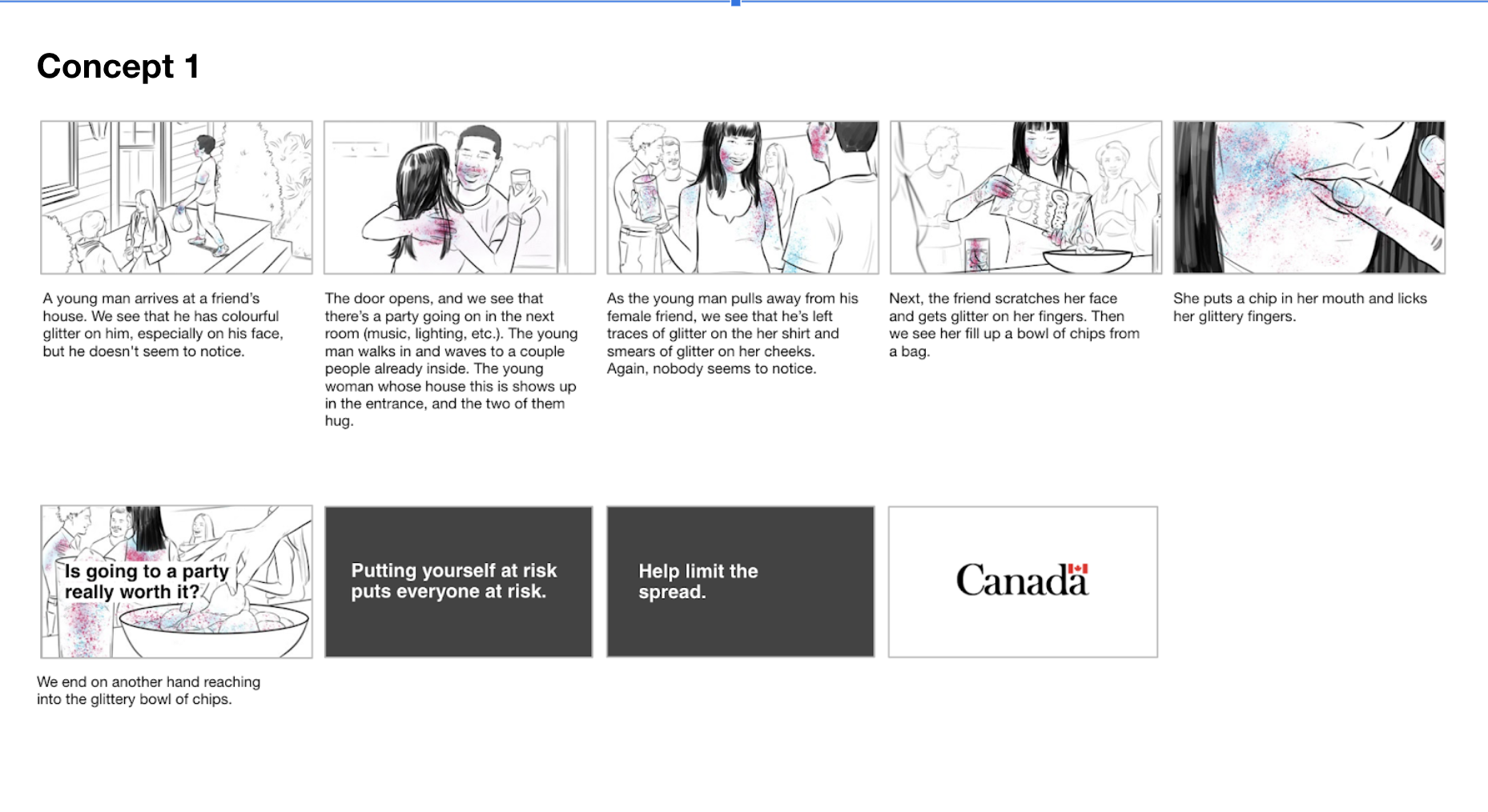
The above storyboard consists of 9 different frames; the first five depict a story and the remaining three consist of text. In the first frame, a young man arrives at a friend’s house. We see that he has colourful glitter on him, especially
on his face, but he doesn’t seem notice. In the next frame, the door opens, and we see that there’s a party going on in the next room (music, lighting, etc.) The young man walks in and waves to a couple of people already inside.
The young woman whose house this is shows up in the entrance, and the two hug. In the following frame, the young man pulls away from his female friend, and we see that he’s left traces of glitter on her shirt and smears of glitter
on her cheeks. Again, nobody seems to notice. In the next frame, the friend scratches her face and gets glitter on her fingers. Then we see her fill up a bowl of chips from a bag. In the next frame, she puts a chip in her mouth
and licks her glittery fingers. In the final story frame, we see another hand reaching into the glittery bowl of chip, and the following black text appears on the screen, “Is going to a party really worth it?” The next frame is
dark grey with white text reading “Putting yourself at risk puts everyone at risk.” This frame is followed by a similar frame that reads, “Help limit the spread.” The final frame is white with the Government of Canada wordmark
in the middle.
Banner
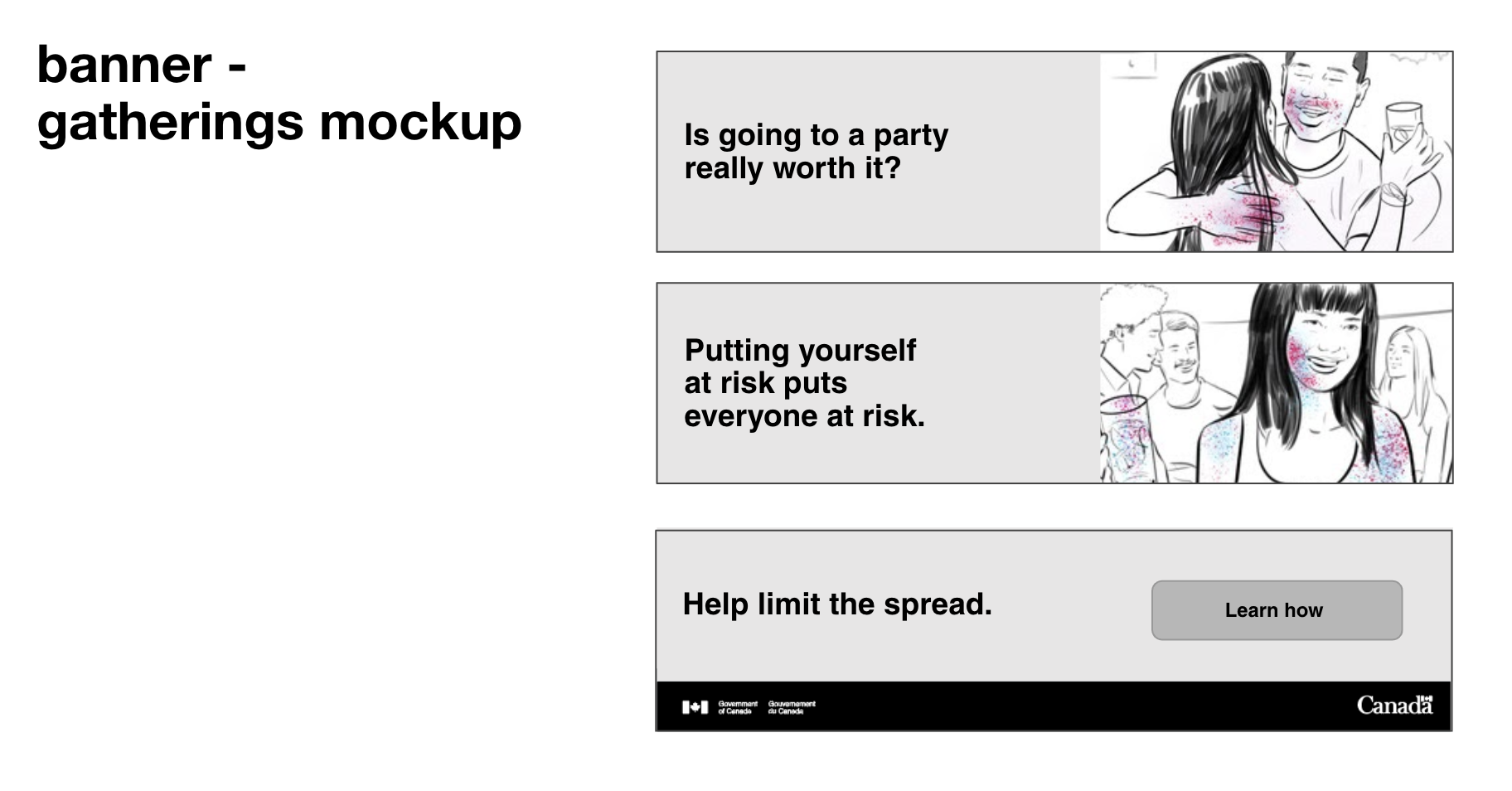
The figure above consists of three frames, all of the same size, font, and colour theme. The left half of the first and top frame is light grey with black font reading, “Is going to a party really worth it?” The right half of the frame
depicts a woman and man embracing in a friendly manner, presumably at a party since the female is holding a drink. The man has colourful glitter around his mouth and on his hands, but nobody seems to notice. The left half of the
second and middle frame looks identical to the first, but reads, “Putting yourself at risk puts everyone at risk.” The image on the right half of the second frame depicts the same woman as in the first image, now, however, she
has glitter on her cheek, shoulder, and in her drink with a group of three people behind her, none of whom notice the glitter. The third and final frame has text reading “Help limit the spread” on the left half of the image, and
the right half has a dark grey with black text button reading “Learn how” with the Government of Canada logo and wordmark in white font against a black background at the bottom of the frame.
Concept 1A
Storyboard
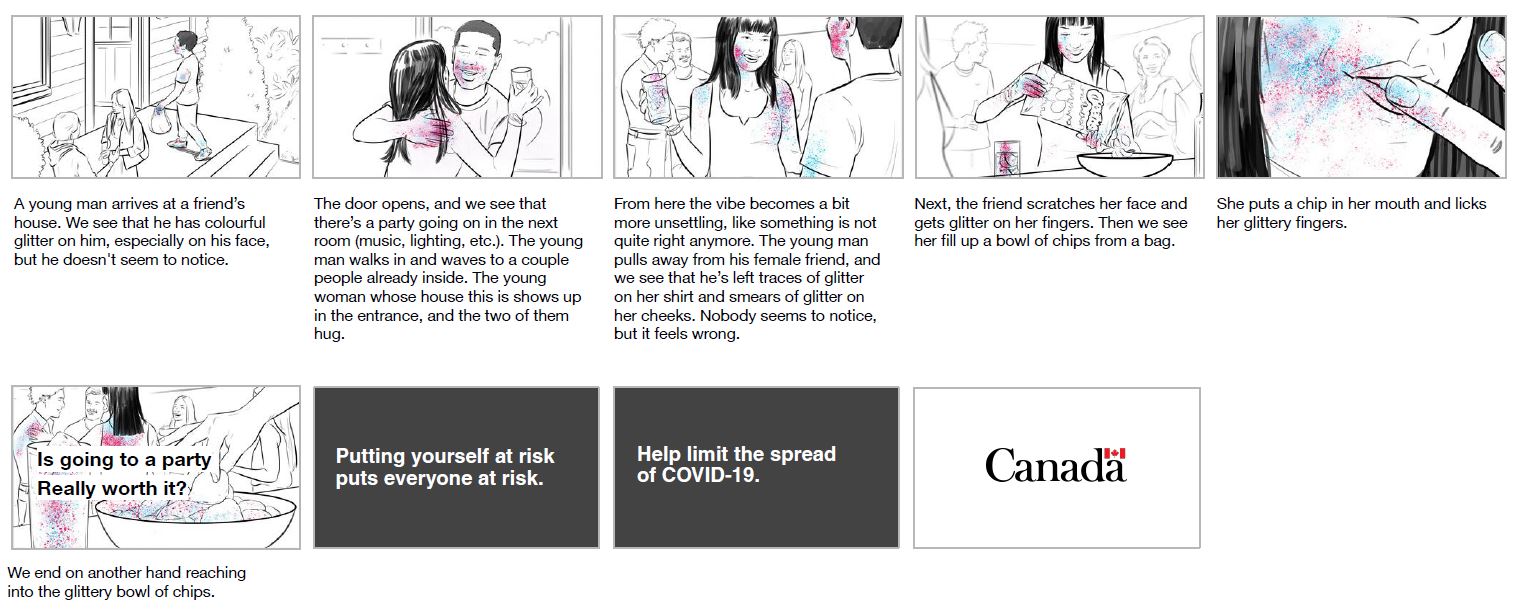
The above storyboard consists of 9 different frames; the first five depict a story and the remaining three consist of text. In the first frame, a young man arrives at a friend’s house. We see that he has colourful glitter on him, especially
on his face, but he doesn’t seem to notice. In the next frame, the door opens, and we see that there’s a party going on in the next room (music, lighting, etc.) The young man walks in and waves to a couple of people already inside.
The young woman whose house this is shows up in the entrance, and the two hug. In the following frame, the young man pulls away from his female friend, and we see that he’s left traces of glitter on her shirt and smears of glitter
on her cheeks. Again, nobody seems to notice. In the next frame, the friend scratches her face and gets glitter on her fingers. Then we see her fill up a bowl of chips from a bag. In the next frame, she puts a chip in her mouth
and licks her glittery fingers. In the final story frame, we see another hand reaching into the glittery bowl of chip, and the following black text appears on the screen, “Is going to a party really worth it?” The next frame is
dark grey with white text reading “Putting yourself at risk puts everyone at risk.” This frame is followed by a similar frame that reads, “Help limit the spread of COVID-19.” The final frame is white with the Government of Canada
logo in the middle.
Banner
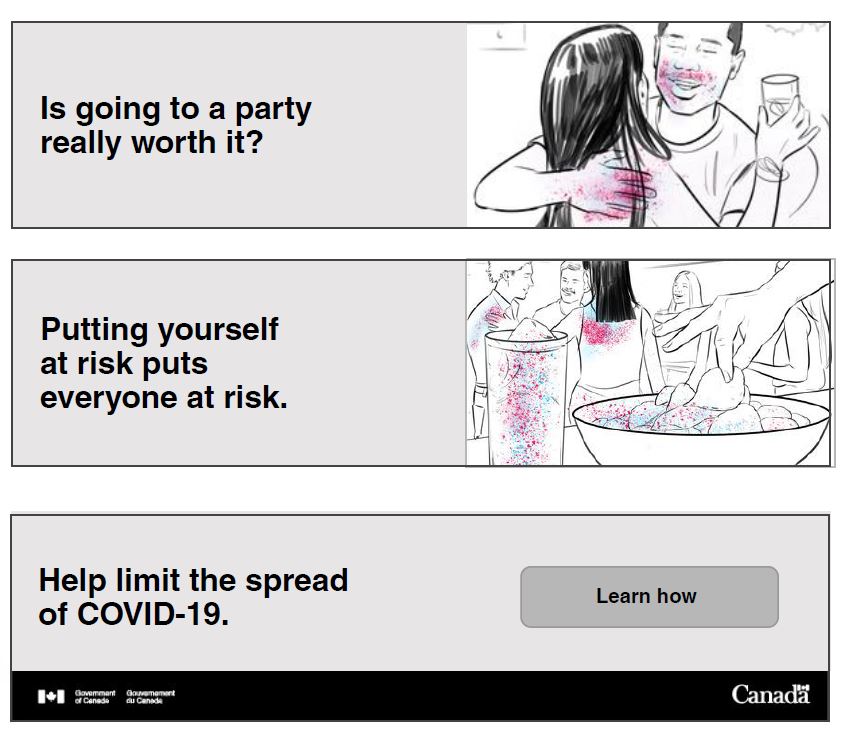
The figure above consists of three frames, all of the same size, font, and colour theme. The left half of the first and top frame is light grey with black font reading, “Is going to a party really worth it?” The right half of the frame
depicts a woman and man embracing in a friendly manner, presumably at a party since the female is holding a drink. The man has colourful glitter around his mouth and on his hands. The left half of the second and middle frame looks
identical to the first, but reads, “Putting yourself at risk puts everyone at risk.” The image on the right half of the second frame depicts a hand reaching into a bowl of chips that are covered in glitter. The drink next to the
bowl and the people in the image’s background are also covered in glitter, with nobody noticing. The third and final frame has text reading “Help limit the spread of COVID-19.” on the left half of the image, and the right half
has a dark grey button reading “Learn how” in black font with the Government of Canada logo and wordmark in white font against a black background at the bottom of the frame.
Concept 1B
Script

The following image is a script that would accompany a storyboard. The text on the image reads: “a young man and his friend enter his parents’ house late at night. We see that they both have a colourful glitter on their faces and hands,
but neither one seems to notice. We cut to inside and watch them enter the kitchen without turning on a light or washing their hands. The young man goes straight to for the fridge while his friend leans on the counter. He takes
out a water jug, pours them two glasses of and sets the jug done. While they sip, a light turns on and illuminates the kitchen. We cut away and see it’s the young man’s mom in a housecoat who switched on the kitchen light. As she
walks over, her son smiles and pours her a glass. From here, the vibe becomes a bit more uncomfortable, like something is not quite right. We see the two young people have left traces of glitter everywhere around the kitchen (jug,
cupboard, counter). As the mom brings the glass to her face, we see her hands and mouth are now covered with glitter. Nobody seems to notice, but it feels wrong. We end on a close up of the fridge with glitter all over it.”
At the bottom of the script, there are three bolded text options, the first of which reads, “is mixing social bubbles really worth it?” secondly, “Putting yourself at risk puts everyone at risk,” and finally, “Help limit the spread
of COVID-19.” Two proposed alternatives are positioned to the right of the previous three text options, the first of which reads, “Is ignoring safety guidelines really worth it?” and secondly, “Is acting like everything’s normal
really worth it?”
Storyboard
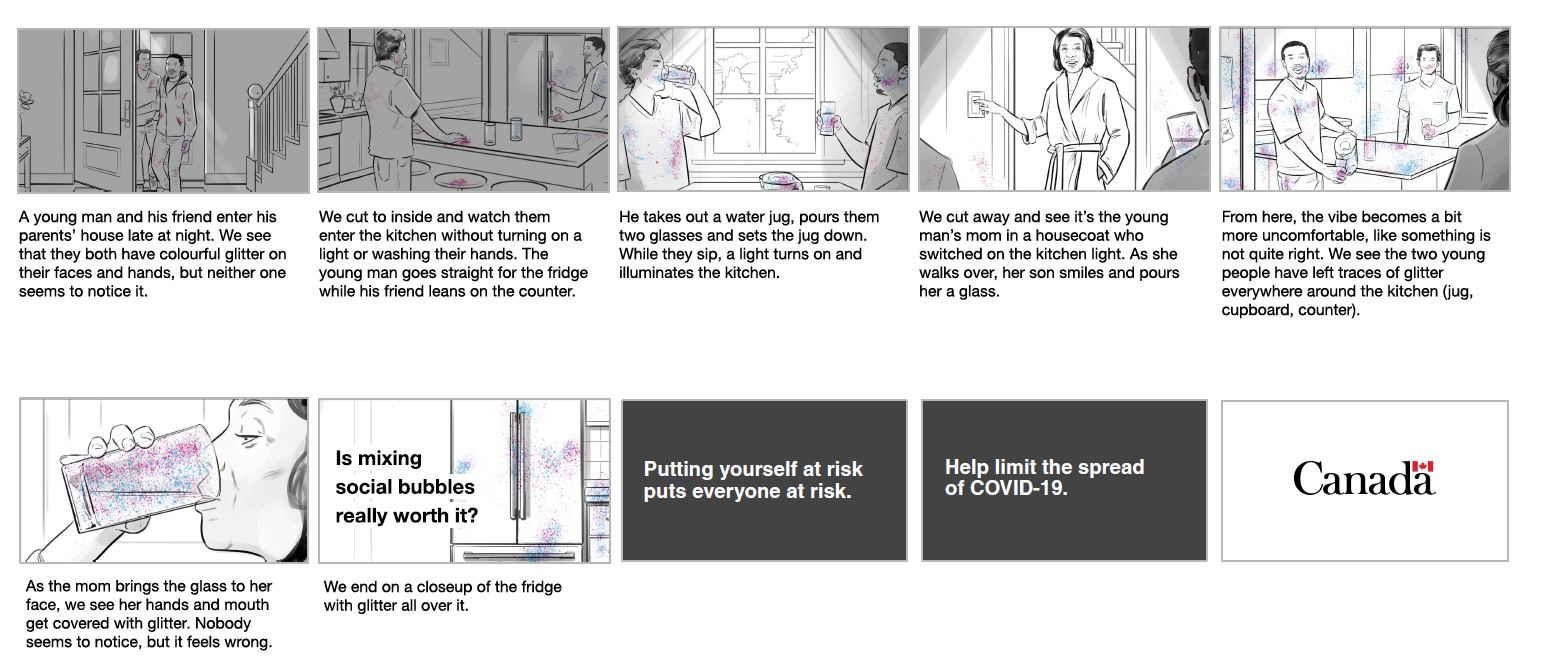
The above storyboard consists of 10 frames, the first seven depict a story consistent with the previous storyboard script, and the final three frames consist of text. The first frame shows a young man and his friend enter his parents’
house late at night. We see that they both have colourful glitter on their faces and hands, but neither one seems to notice it. In the next frame, we cut inside and watch them enter the kitchen without turning on a light or washing
their hands. The young man goes straight for the fridge while his friend leans on the counter. In the next frame, he takes out a water jug, pours them two glasses, and sets the jug down. While they sip a light turns on and illuminates
the kitchen. In the following frame, we cut away and see it’s the young man’s mom in a housecoat who switched on the kitchen light. As she walks over, her son smiles and pours her a glass. In the next frame, the vibe becomes a
bit more uncomfortable, like something is not quite right. We see the two young people have left traces of glitter everywhere around the kitchen (jug, cupboard, counter). In the next frame, the mom brings the glass to her face,
we see her hands and mouth get covered with glitter. Nobody seems to notice, but it feels wrong. In the final frame, we end on a close up of the fridge with glitter all over it. The text “Is mixing social bubbles really worth it?”
also appears on the screen. The following frame is dark grey with white text reading “Putting yourself at risk puts everyone at risk.” This frame is followed by a similar frame that reads, “Help limit the spread of COVID-19.” The
final frame is white, with the Government of Canada wordmark in the middle.
Concept 2
Storyboard
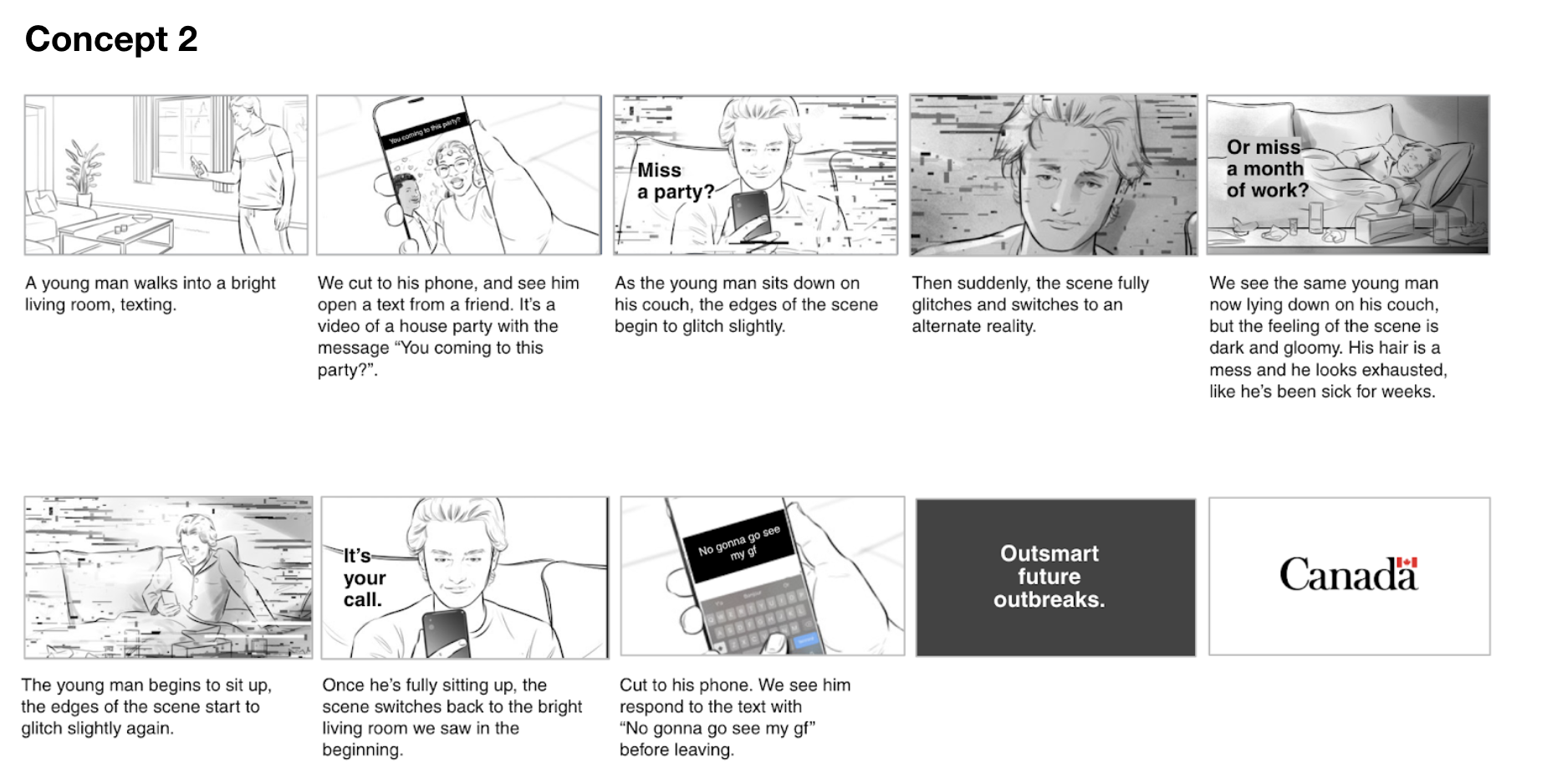
The above storyboard consists of 10 different frames; the first 8 depict a story, and the remaining two consist of text. In the first frame, a young man walks into a bright living room, texting. The next frame cuts to his phone, and
we see him open a text from a friend. It is a video of a house party with the message “You coming to this party?” In the next frame, the young man sits down on his couch, the edges of the screen begin to glitch slightly, and the
black text “Miss a party?” appear on the screen. In the following frame, the scene suddenly fully glitches and switches to an alternate reality. On the following frame, we see the same young man now lying down on his couch, but
the feeling of the scene is dark and gloomy. His hair is a mess and he looks exhausted, like he’s been sick for weeks. The black text “Or miss a month of work?” also appears on the screen. In the next frame, the young man begins
to sit up; the scene’s edges start to glitch slightly again. In the following frame, once he is fully sitting up, the scene switched back to the bright living room we saw in the beginning. The black text “It’s your call.” also
appears on the screen. In the final story frame, we cut to his phone. We see him respond to the original text with “No gonna go see my gf” before leaving. The next slight is dark grey with white text reading “Outsmart future outbreaks.”
The final frame is white with the Government of Canada wordmark.
Banner
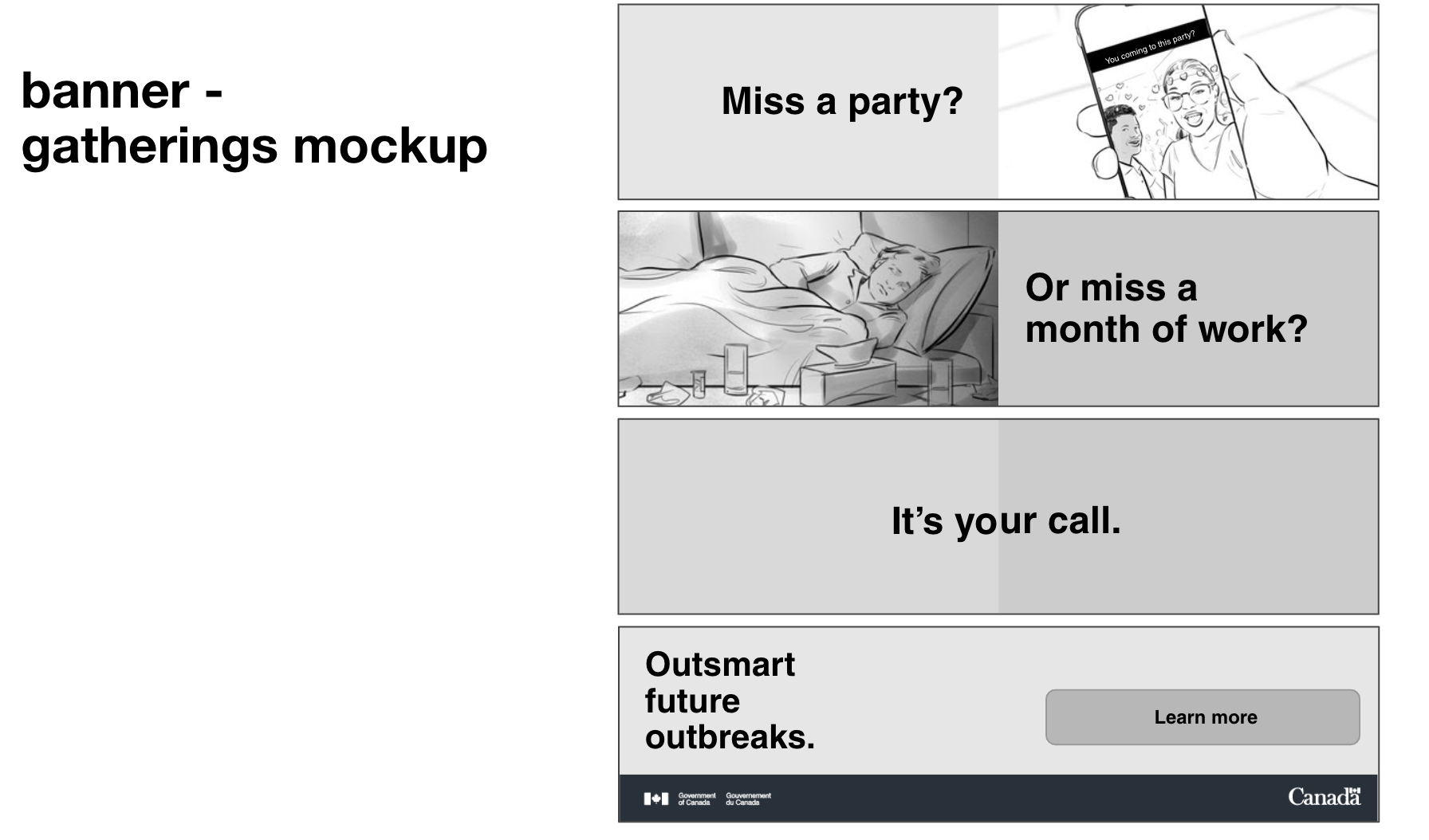
The figure above consists of 4 frames. The first frame is divided into two sections; the left section has a light grey background with black text reading “Miss a party?” and the right half of the image shows a cell phone, playing a
video of people at a party with the accompanying text message reading “You coming to this party?”. The second frame is similarly split in half, with the left side depicting a young man lying on the couch, looking very sick. The
right half of the frame reads, “Or miss a month of work?” against a similar grey background. The third frame is all grey, and the black text in the middle reads “It’s your call.” The final frame has text reading “Outsmart future
outbreaks” on the left half of the image, and the right half has a dark grey button reading “Learn more” in black font with the Government of Canada logo and wordmark in white font against a black background at the bottom of the
frame.
Concept 2A
Storyboard
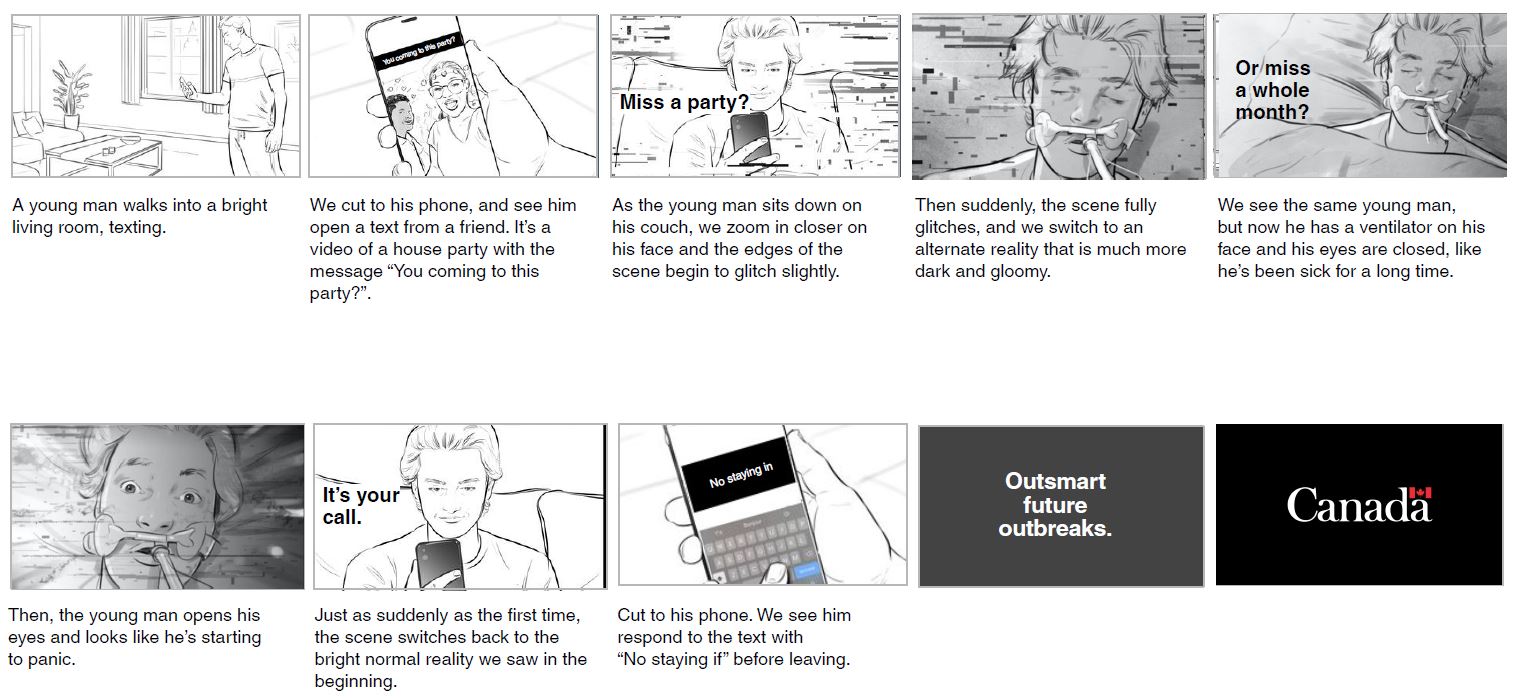
The story board consists of 10 different frames, the first 8 of which depict a story and the remaining two consist of text. In the first frame, a young man walks into a bright living room, texting. The next frame cuts to his phone,
and see him open a text from a friend. IT is a video of a house party with the message “You coming to this party?” In the next frame, the young man sits down on his couch, the edges of the screen begin to glitch slightly and the
text “Miss a party?” Appear on screen. In the frame, suddenly the scene fully glitches and switches to an alternate reality, which is much more dark and gloomy. On the following frame, we see the same young man now, but now he
has on ventilator on his face and his eyes are closed, like he has been sick for a long time. The text “Or miss a whole month?” also appears on screen. In the next frame, the young man opens his eyes and looks like he’s starting
to panic. In the following frame, and just as suddenly as this first time, the scene switches back to the bright, normal reality we saw in the beginning. The black text “It’s your call.” also appear on the screen. In the final
frame of the story, we cut to his phone and see him respond to the text with a “no staying in” before leaving. The next slight is dark grey with white text reading “Outsmart future outbreaks.” The final frame is white with the
Government of Canada wordmark.
Banner
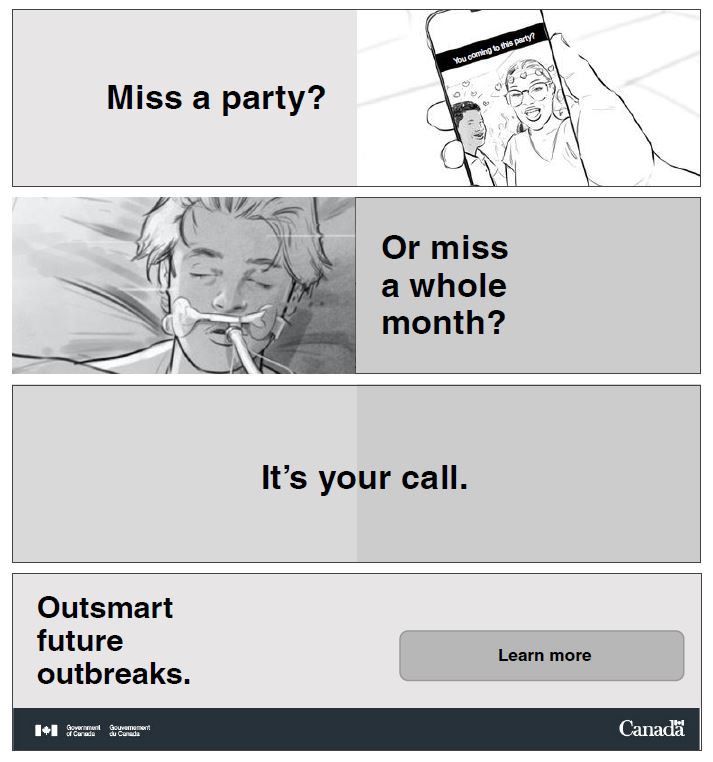
The figure above consists of 4 frames. The first frame is divided into two sections; the left section has a light grey background with black text reading “Miss a party?” and the right half of the image shows a cell phone, playing a
video of people at a party. The second frame is similarly split in half, with the left side depicting a young man lying in a hospital bed and on a ventilator, looking very sick. The frame’s right half reads, “Or miss a whole month?”
against a similar grey background. The third frame is all grey, and the black text in the middle reads, “It’s your call.” The final frame has text reading “Outsmart future outbreaks” on the left half of the image, and the right
half has a dark grey button reading “Learn more” in black font with the Government of Canada logo and wordmark in white font against a black background at the bottom of the frame.
Concept 3
Storyboard

The above storyboard consists of 9 different frames; the first 7 depict a story, and the last two consisting of text. There is also a note that accompanies the entire storyboard reading, “SFX: Hype music plays throughout, creating
a dynamic rhythm for the editing (think Nike ads).” The storyboard’s first frame depicts a young woman looking in the mirror with a determined look on her face. The next frame shows the same woman with black text on the screen
reading, “Always ready for anything.” In the next frame, the screen suddenly splits into two, and on the right half of the screen half, we see a young man also getting ready and washing his hands. In the next frame, the screen
splits again, and on the rightmost frame, we see another young person also getting ready and packing a mask into a backpack. The next frame follows all three characters with quick cuts, seeing them putting on shoes, grabbing keys,
grabbing sanitizer, and leaving the house. The following frame continues to follow the three characters, and it feels like they’re getting ready for something epic. The final story frame ends on an outdoor park scene where the
three people arrive separately to meet at a park to enjoy an evening together. There is also black text on the screen that reads “Including a night with a few friends.” The next frame is dark grey and has white text reading, “Together
we’re unstoppable.” The final frame is white with the Government of Canada word mark in the middle.
Banner
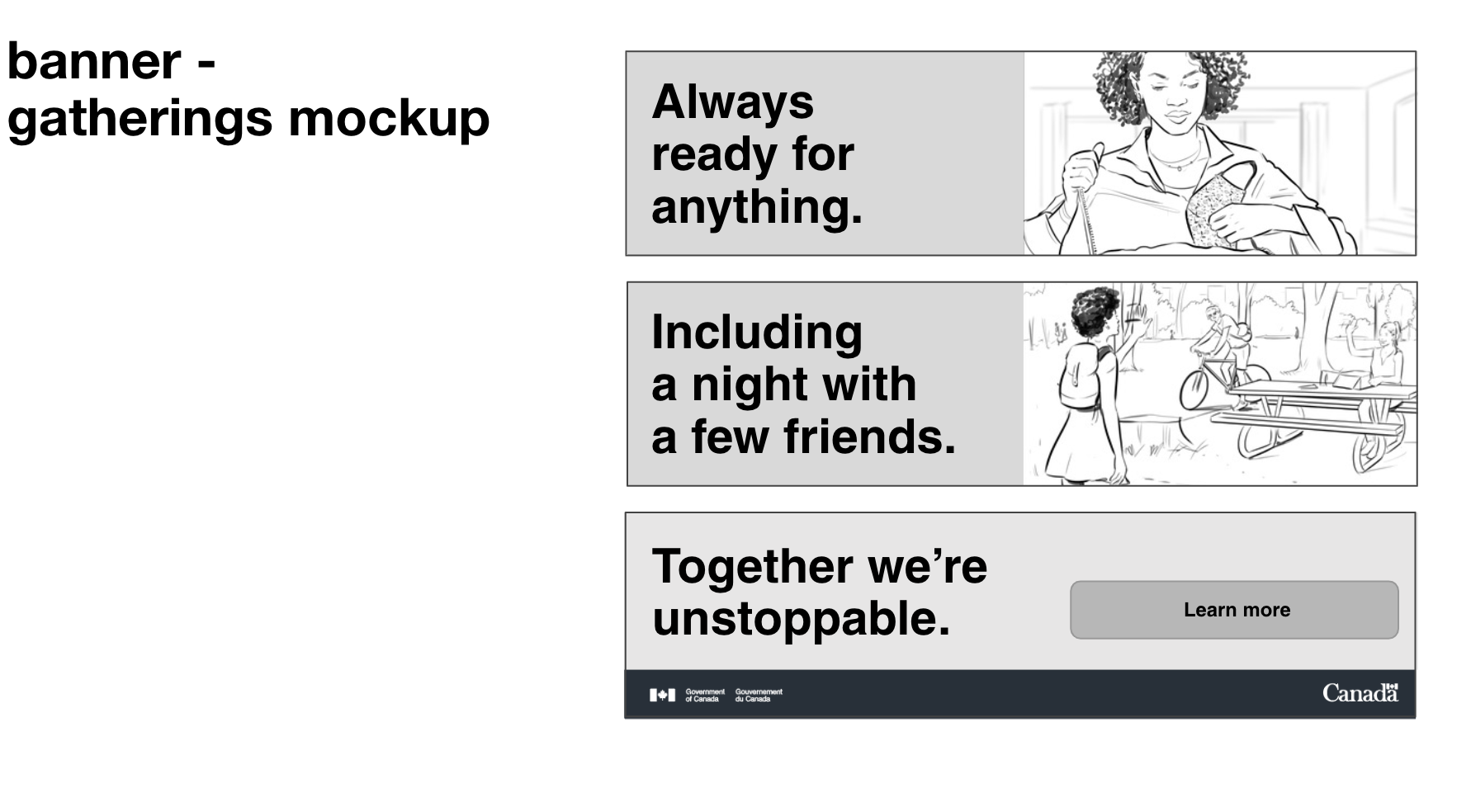
The above banner consist of thee frames. The first frame is divided into two sections; the left portion has a light grey background with black text reading “Always ready for anything.” and the right half of the image shows a young
woman packing a mask into a bag. The second frame is similarly split in half, with the left side reading “Including a night with a few friends.” The frame’s right half depicts the same woman heading to a park while two other characters
are also arriving separately. The final frame has text reading “Together we are unstoppable.” on the left half of the image, and the right half has a dark grey button reading “Learn more” in black text with the Government of Canada
logo and wordmark in white font against a black background at the bottom of the frame.
Video Concepts
Video 1
The video begins with a young woman walking into a house and hugging a young man. The young woman has colourful glitter on her face and hands, but neither character seems to notice. As the two pull away, we see that now the young man
has the same glitter on his chest and face, but again, nobody notices. We then see the two characters talking, with the young woman touch the arm of the young man, beside a table with a bowl of chips and a few cups, all of which
have clear glittery handprints. There are also people in the background, suggesting they are at a party. The young man then reaches for and eats a chip while audio saying, “Is going to a party really worth it?” plays. We then see
a close up of the bowl of chips that the young man just ate from, nearly completely covered with glitter. Yellow text and audio then play “Putting yourself at risk puts everyone at risk.” A pink screen with lighter pink font then
appears, along with audio, reading “Help limit the spread of COVID-19.” The ad ends with a black screen and the Government of Canada wordmark.
Video 2
The video begins with a young man and woman talking and friendly grabbing hands at a party (there are many people in the background of the scene) in front of a table holding a bowl of chips and a few cups. The young man has a colourful,
glittery handprint on his shoulder, the young woman has the same glitter on his chest, and the cups and chips have clear glitter handprints too, but no one seems to notice. The young man eats a chip from the glittery bowl. We then
cut to the same young man, now home in his kitchen. He has much more glitter on him than when we last saw him, and it is also all over his kitchen, including the counter, fridge, and cupboards. There is a box of cookies on the
counter that he is eating from, also covered in glitter. The young man’s mother walks in, wearing a housecoat. She comes over and eats a cookie from the glitter-covered box. Audio plays, “Is going to a party really worth it?” We
then pan to the mother, eating the cookie. She, too, now has glitter around her mouth. We then see her reach for another cookie from the glittery box, next to a milk cup with the same glitter on it. Audio and yellow text on the
screen reads, “Putting yourself at risk puts everyone at risk.” A pink screen with lighter pink font then appears, along with audio, reading “Help limit the spread of COVID-19.” The ad ends with a black screen and the Government
of Canada wordmark.
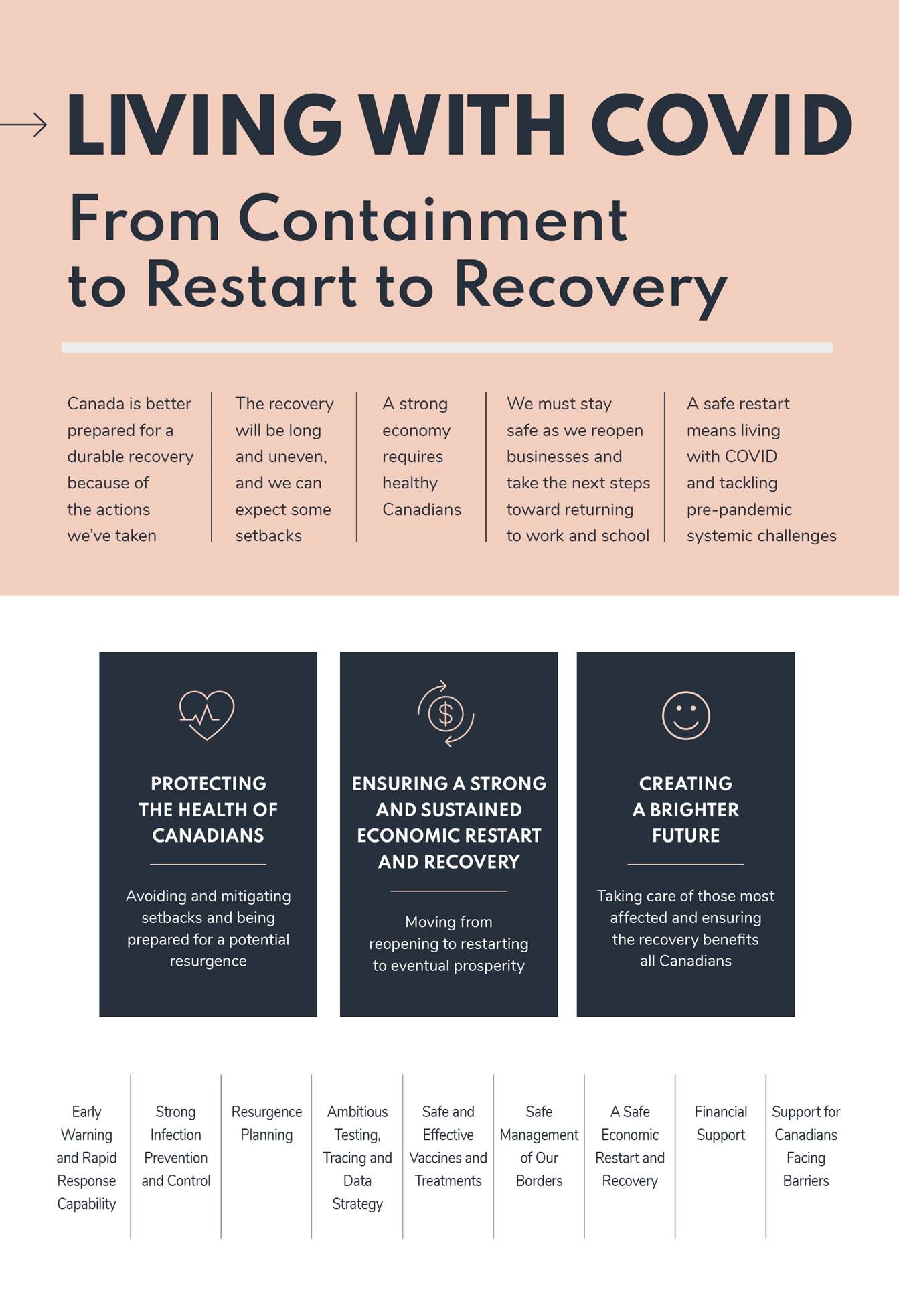
The top half of the image has a light pink backdrop. At the top of the pink portion of the image, in dark blue font, is text that reads "Living with COVID" in all capital letters. There is also a blue arrow on the left side of the
title, point towards it. Under this title, in a slightly smaller dark blue font, is a subtitle reading "From Containment to Restart to Recovery." Below these titles is a white line separating the titles from five smaller text boxes
that are all separated by vertical blue lines. From left to right in dark blue font, they, in order from left to right, read, "Canada is better prepared for a durable recovery because of the action we've taken;" "The recovery will
be long and uneven, and we can expect some setbacks;" "A strong economy requires healthy Canadians;" "We must stay safe as we reopen businesses and take the next steps towards returning to work and school;" and "A safe restart
means more than 'returning to normal', given pre-pandemic systematic challenges." The image's background below these text boxes becomes white, and there are three blue boxes in a horizontal row. In the first box, there is a heart
with a heartbeat line enclosed in pink at the box's top. Below this, white text reads "Protecting the Health of Canadians" in all capital letters, and below that text is smaller white text reading "Avoiding and mitigating setbacks
and being prepared for a potential resurgence." In the second and middle box, there is a dollar sign enclosed in a circle with two arrows that indicate turning in a circle in pink at the top. Below this symbol, white text reads,
"Ensuring a strong and sustained economic restart and recovery" in capital letters. Below, there is smaller white text reading, "Moving from reopening to restarting to eventual prosperity." In the rightmost box, there is a happy
face in pink text at the top, and below the happy face, there is white text reading, "Creating a brighter future," again in all capital letters. Below, smaller white text reads, "Taking care of those most affected and ensuring
the recovery benefits all Canadians." Underneath these blue boxes, there are nine pieces of blue text, all separated by blue vertical lines. They read, in order from left to right, "Early Warning and Rapid Response Capabilities;"
"Strong Infection Prevention and Control;" "Resurgence Planning;" "Safe and Effective Vaccines and Treatments;" "Safe Management of Our Borders;" "A Safe Economic Restart and Recovery;" "Financial Support;" and finally, "Support
for the Vulnerable."
Please note: the background colour of the above figure was different during testing.




